Universal Copper (TSXV:UNV) has reported new results from the first three of its five holes for its Spring 2022 diamond drilling program. The program is being done at the Poplar Copper Deposit, located southwest of the town of Houston, in British Columbia. The Poplar Copper Deposit is the company’s flagship deposit, with every drill target in the copper-gold exploration district being shallow and easily accessible. Additionally, drilling is aided by the deposit by the district being located within just 88 kilometres of rail infrastructure for easier access.
Clive Massey, Universal Copper’s CEO, commented in a press release: “A second, significant open-ended, copper intercept in the bottom 216 metres of drill hole 137, one hundred and twenty-five metres NE of drill hole 135 further supports our new interpretation that the system is tilted and that the high-grade zone plunges eastward. Today’s results represent the newest of four H1 2022 releases to-date reporting robust copper grades, as we continued to push the copper mineralization both outward and to depth from the known core mineralized zone. The strong mineralization in Hole 137 follows up on the January 18th, 2022, January 25th, 2022, and March 23, 2022 reported intersections. Universal Copper is focused on leveraging our new exploration model and building the Poplar Project into a premier deposit in a metal endowed, road/rail accessible emerging exploration district in a top-tier jurisdiction”.
Highlights from the results are as follows:
Hole 22-PC-137 – 0.535% copper equivalent (CuEq)– 0.353% copper, 0.14 g/t gold and 5.91 g/t silver over the last 216 metres of the hole,
- including 24 metres at 0.692% CuEq – 0.402% copper, 0.15 g/t gold and 8.86 g/t silver
- including 87 metres at 0.783% CuEq – 0.531% copper, 0.36 g/t gold and 20.67 g/t silver
- and including the bottom 42 metres at 0.512% CuEq – 0.411% copper, 0.15 g/t gold and 8.61 g/t silver
- Hole 22-PC-130B – 0.468% copper equivalent (CuEq) – 0.316% copper, 0.019% molybdenum, 0.08 g/t gold and 3.34 g/t silver over 153 metres
Table 1. 22-PC-130, 22-PC-130B and 22-PC-137 intersections.
| HOLE | FROM | TO | LENGTH | Cu | Mo | Au | Ag | CuEQ* |
| ID | (m) | (m) | (m) | (%) | (%) | (g/t) | (g/t) | (%) |
| 22-PC-137 | 165 | 219 | 54 | 0.423 | 0.000 | 0.17 | 4.85 | 0.560 |
| 22-PC-137 | 309 | 525 | 216 | 0.353 | 0.002 | 0.14 | 5.91 | 0.535 |
| 22-PC-137 | 309 | 333 | 24 | 0.402 | 0.002 | 0.15 | 8.86 | 0.692 |
| 22-PC-137 | 351 | 438 | 87 | 0.531 | 0.003 | 0.36 | 20.67 | 0.783 |
| 22-PC-137 | 483 | 525 | 42 | 0.411 | 0.003 | 0.15 | 8.61 | 0.512 |
| 22-PC-130 | 24 | 111 | 87 | 0.309 | 0.013 | 0.087 | 2.68 | 0.432 |
| 22-PC-130B | 27 | 180 | 153 | 0.316 | 0.019 | 0.087 | 3.34 | 0.468 |
| 22-PC-130B | 27 | 381 | 354 | 0.292 | 0.019 | 0.077 | 2.62 | 0.435 |
| 22-PC-130B | 27 | 510 | 483 | 0.262 | 0.017 | 0.073 | 2.30 | 0.391 |
* Copper equivalents based on the following: copper US$9,972.10 per tonne, gold US$1,816.60 per ounce, silver US$22.90 and molybdenum US$41,836.39 per tonne.
Because of the disseminated nature of the mineralization at the Poplar Deposit, it is not possible to make a statement as to the true width for holes 22-PC-130, 22-PC-130B and 22-PC-137.
Figure 1. Drill Hole Locations
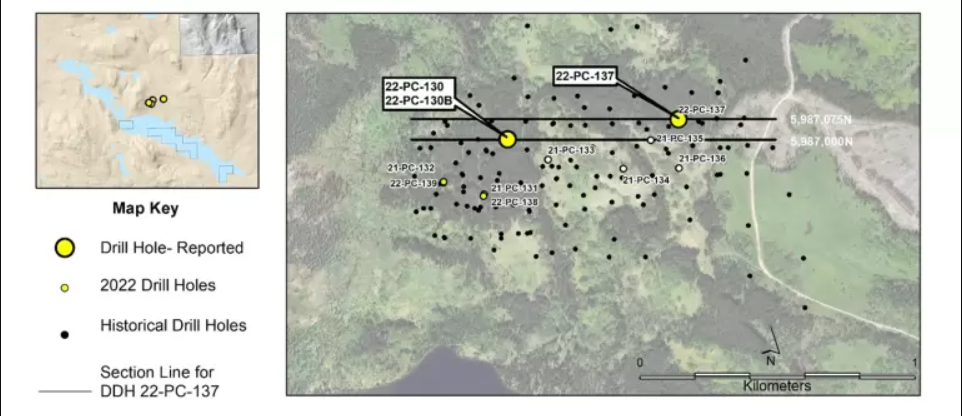
The 2022 Poplar drill holes were designed to: a) follow-up on the 0.546% copper over 129 metres discovered in the bottom of 21-PC-135; b) expand the higher-grade portion of the known mineralization to the northwest and c) test the first of the Vector Geological Solutions targets identified from their early 2022 targeted core logging initiative announced on January 13th, 2022.
Hole 22-PC-137 successfully extended mineralization encountered in 21-PC-135 over 125 metres toward to the northeast and mineralization in these two holes remains open at depth (Fig.1; Fig. 2). It is encouraging that copper grades in PC-68 and PC-42 increase over their lower portions as shown in Figure 2 – Section 5987075N, where they cut the top of a northeast plunging zone of mineralization.
Recent geological modeling by Universal Copper’s technical team demonstrates that portions of the Poplar Deposit are rotated significantly, and the company intends to extend historic drill holes such as PC-67 and PC-42 to intercept these newly recognized low angle mineralized geometries.
Figure 2. Section 5987075N
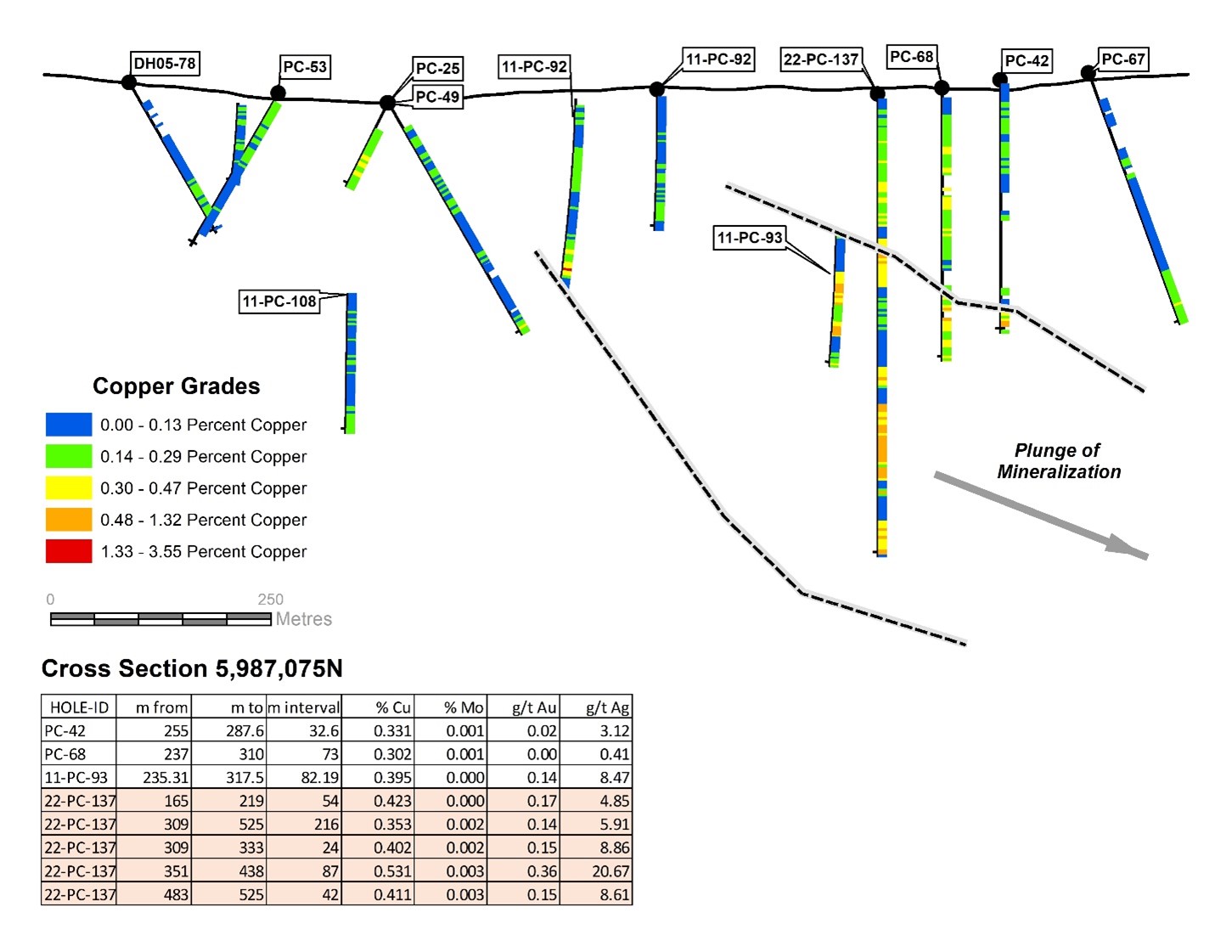
Mineralization and alteration at Poplar is associated with intensely altered porphyry intrusions and consists of pyrite, chalcopyrite and molybdenite and trace bornite. Pyrite and chalcopyrite form disseminations, fracture fillings, stringers, veins, and veinlets in domains of dense quartz vein stockwork and dikes. Molybdenite, where observed is associated with quartz-sulphide veins, and is typically associated with pyrite and chalcopyrite.
Potassic alteration (biotite and K-feldspar) of varying intensity and silicification were noted throughout 22-PC-137, with sodic-calcic and sericite alteration increasing with depth. There is a considerable volume of post mineralization dikes in hole 22-PC-137, which was also noted in the earlier 2021 drilling within the East Zone, with roughly 25% of the hole intersected late dykes of various widths and compositions.
Figure 3. Section 5987000N
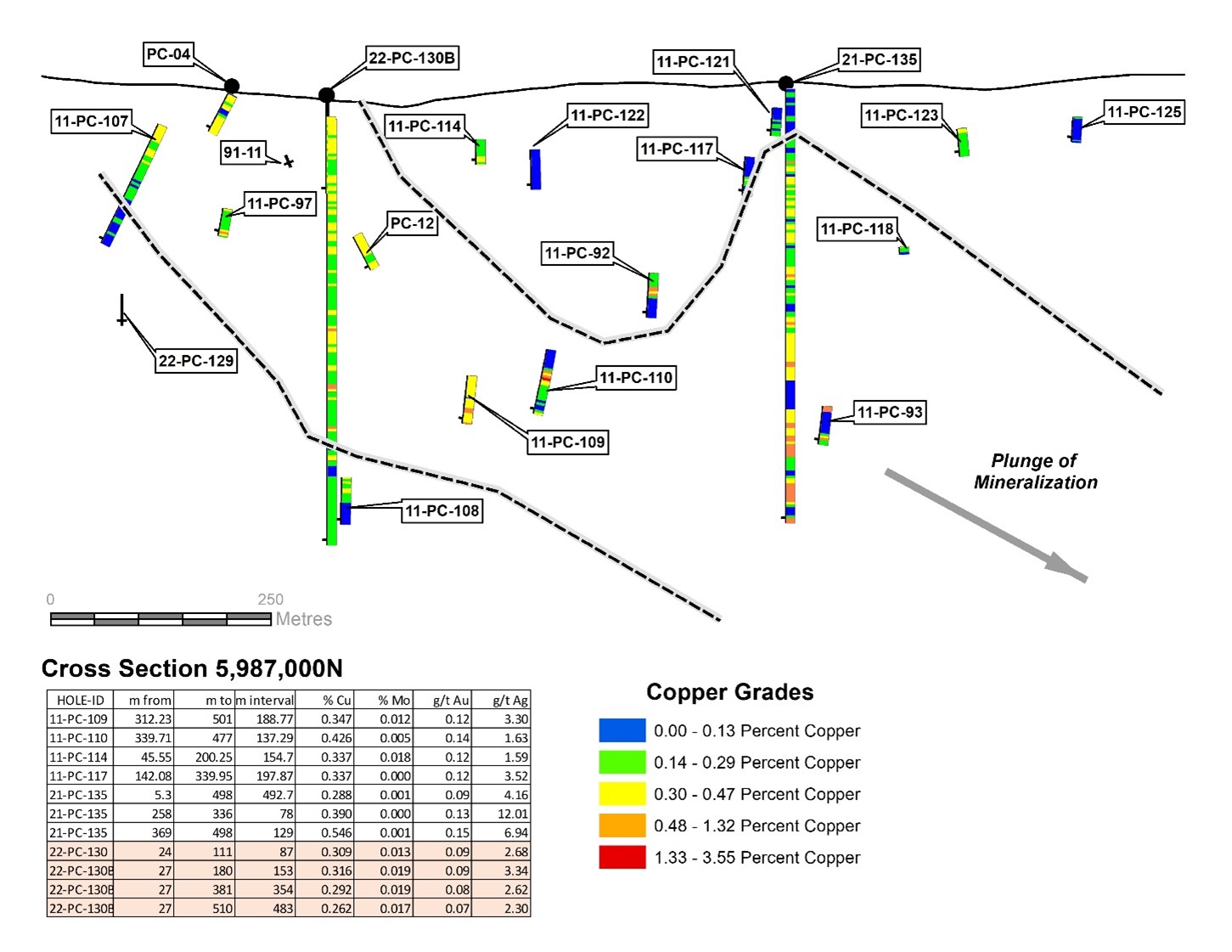
Hole 22-PC-130 was drilled vertically to test the northeast section on the Main Zone. The hole caved at 111 metres and was abandoned. Drill hole 22-PC-130B was collared one metre behind 22-PC-130 and reached planned depth (Fig. 1; Fig. 3).
The top 180 metres of 22-PC-130B carried good copper mineralization mostly above 0.3% Cu. Copper grades drop below 0.3% below 180 metres, and multiple shorter (<10 metre) sections of 0.3% to 0.65% were noted to 380 metres. A significant fault is observed at 401m.
Mineralization in hole 22-PC-130 consists of disseminated pyrite and chalcopyrite, quartz veinlet pyrite, chalcopyrite and local molybdenite. Alteration consists of moderate to intense potassic, silicification and sericite throughout the hole.
The ongoing data compilation and targeting programs continue to leverage decades of work in the district. These programs are nearing their conclusion and progress report is anticipated early Q3.
Table 2. Drill Hole Data
| 22-PC-137 Statistics | 22-PC-130B Statistics | ||||||||
| ppm Cu | ppm Mo | g/t Au | g/t Ag | ppm Cu | ppm Mo | g/t Au | g/t Ag | ||
| Max | 7970 | 255 | 3.230 | 175.00 | 6330 | 1220 | 0.364 | 21.50 | |
| Min | 3 | 1 | 0.001 | 0.14 | 677 | 24 | 0.014 | 0.26 | |
| Median | 2610 | 6 | 0.073 | 2.43 | 2570 | 134 | 0.070 | 1.16 | |
| Mean | 1051 | 7 | 0.048 | 2.21 | 2477 | 134 | 0.067 | 1.43
|
|
The above references an opinion and is for information purposes only. It is not intended to be investment advice. Seek a licensed professional for investment advice. The author is not an insider or shareholder of any of the companies mentioned above.
Collective Mining (TSXV:CNL) has announced today new high-grade gold and silver channel sample assay results from the Trap target at its Guayabales project in Colombia. The Trap target is in the northern portion of the 4 x 4 kilometre porphyry cluster where Collective has already generated eight drill targets through grassroots prospecting. The company has three diamond drill rigs running at Guayabales at the Trap and Apollo targets and expects a fourth rig to begin a phase II drill program for the Olympus target in late June 2022.
Drill testing has been completed for four of the targets, not including the Trap target, with three significant discoveries including the Olympus target. The company announced near-surface discovery holes of 302 metres @ 1.11 g/t gold equivalent and 216.7 metres @ 1.08 g/t gold equivalent from the Olympus target on March 15, 2022, and May 9, 2022..
Ari Sussman, Executive Chairman, Collective Mining, commented in a press release: “The discovery of a new, high-grade vein system at Trap reconfirms just how prospective the Guayabales project is and to date we have outlined multiple styles of potentially economic mineralization within eight precious and base metal targets. Although exploration at the Trap target is in its infancy, we have already outlined a mineralized corridor consisting of multiple CBM vein systems with a strike length of at least 1.2 kilometres. First assay results from this program are expected in late Q3, 2022.”
Highlights of the results are as follows:
Highlights (Table 1 and Figures 1 and 2)
- Assay results of 33 reconnaissance chip channel samples taken from porphyry related, carbonate-base metal (“CBM”) veins within the Trap target confirm the presence of multiple, high grade, polymetallic veins. Channel sample assay highlights are as follows:
- 28.41 g/t AuEq over 0.30 metres
- 15.50 g/t AuEq over 0.25 metres
- 7.19 g/t AuEq over 2.2 metres
- 5.07 g/t AuEq over 1.7 metres
- The CBM veins hosted within the Trap target are all located within a north-to-south trending corridor that has been mapped for a strike length of 1.2 kilometres and is open in both directions along strike. The veins occur within a zone up to 100 metres in width and are hosted within a quartz diorite porphyry which has been bleached white by intense sericite alteration and contains multiple discrete shear planes. The CBM veins are sulphide-rich (pyrite, chalcopyrite, sphalerite and galena) and are associated with quartz carbonate veins within this structural corridor.
- The Company is presently drilling the first reconnaissance diamond hole, TRC-1, into the central portion of the target area where the vein density is highest. Up to five widely spaced diamond holes covering 600 metres of strike length will be drilled to understand the grade tenor and continuity of the target.
Table 1: Chip Channel Sample Assay Results
Sample IDLength (m)Au (g/t)Ag (g/t)Zn %Pb%Cu%Mo%AuEq (g/t)*CM32940.303.4668713.061.541.860.00128.41R50240.258.942270.270.061.630.00215.50CM34190.1410.612830.020.420.010.00114.79R50020.708.53120.090.130.020.0028.47R55590.608.081 7.69R50260.600.491723.821.390.300.0017.30R50252.203.90383.230.280.150.0017.19R55610.305.6910 5.56R50591.705.07140.010.000.060.0025.19CM34310.083.88690.000.140.000.0024.85R50390.704.63180.010.020.020.0004.74R55570.204.193 4.03R50571.001.91760.070.000.110.0123.36R50631.402.14550.040.040.140.0053.27R51531.000.661330.030.000.200.0073.19R51541.502.35180.030.000.220.0223.13R50472.002.11220.680.250.020.0013.02R50641.200.89800.030.000.390.0143.00CM34240.602.53110.400.070.020.0002.95R51562.001.59430.060.010.250.0032.75R50580.301.3940.020.000.520.0022.44R51351.001.57460.020.020.050.0022.36R50612.001.73170.020.010.140.0012.22CM003882.001.9740.010.000.010.0062.00R51370.901.43230.070.010.030.0061.87CM003291.501.54200.020.050.010.0031.86CM003471.801.8910.040.010.000.0001.86R51380.251.08200.050.010.210.0021.81R55580.401.881 1.80R51362.001.09190.020.010.140.0021.64R55690.701.4410.000.000.000.0001.38CM003471.001.1100.050.140.020.0001.21R50030.401.0150.060.020.030.0011.15
*Channel chip samples reported above are over true horizontal sampling widths. Sample grades are uncapped. Channel samples are representative of 2-dimensional space and as a result, should not be relied upon as being representative of average grades anticipated in any future resource estimate or mining scenario. AuEq (g/t) is calculated as follows: (Au (g/t) x 0.95) + (Ag g/t x 0.017 x 0.95) + (Cu (%) x 2.06 x 0.95) + (Mo (%) x 6.86 x 0.95) +(Zn(%)*0.80*0.95)+(Pb(%)*0.46*0.95), utilizing metal prices of Cu – US$4.50/lb, Mo – US$15.00/lb, Zn – 1.75 US$15.00/lb, Pb – US$1.00/lb, Ag – $25/oz and Au – US$1,500/oz and recovery rates of 95% for Au, Ag, Cu; Zn; Pb and Mo. Recovery rate assumptions are speculative as no metallurgical work has been completed to date.
Source: Collective Mining
Figure 1: Plan View of the Guayabales Project Highlighting the Trap Target
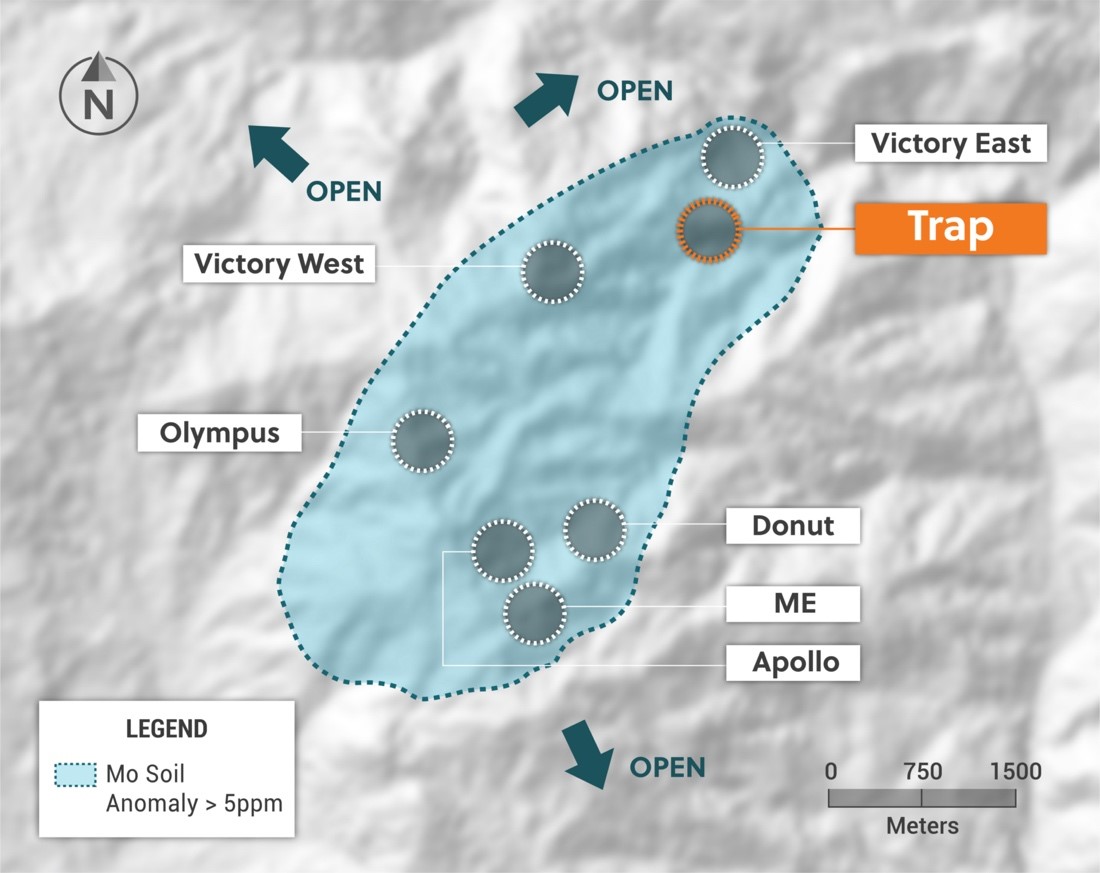
Figure 2: Trap Target has a 1.25 km Strike Length and is Open in Both Directions Along Strike
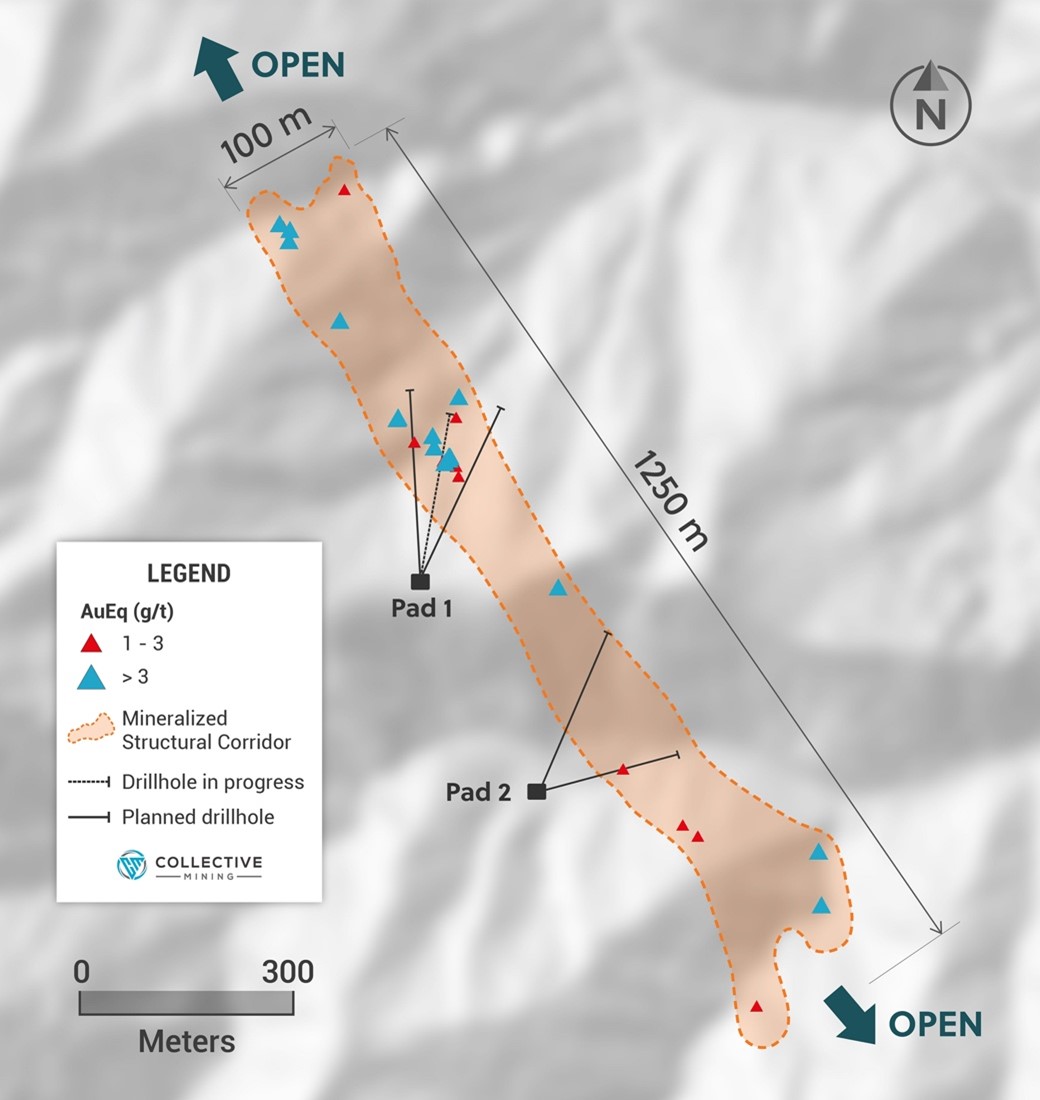
The above references an opinion and is for information purposes only. It is not intended to be investment advice. Seek a licensed professional for investment advice. The author is not an insider or shareholder of any of the companies mentioned above.
Solaris Resources (TSX:SLS) (OTCQB:SLSSF) has reported assay results from a series of holes at the Warintza Project. The drilling at the holes is aimed at upgrading and growing mineral resources at the project, which was recently released.
Mr. Jorge Fierro, Vice President, Exploration, commented in a press release: “Ongoing follow-up drilling from existing and newly constructed platforms aims to expand on the Northeast Extension zone and grow the high-grade indicative starter pit, while also targeting areas within Warintza Central where resource classification can be upgraded with targeted drilling. In addition, we have completed a considerable amount of drilling from our recent Warintza East discovery targeting major growth with assays pending.”
Highlights are listed below, with a corresponding image in Figure 1 and detailed results in Tables 1-2.
Northeast Extension
SLS-57 was collared at the northeastern limit of the Warintza Central grid and drilled northeast into an entirely open volume, returning 230m of 0.73% CuEq¹ from 56m depth within a broader interval of 926m of 0.61% CuEq¹ from surface, extending the zone 200m to the northeast where it remains open.
Additional drilling aimed at expanding the zone to the north from this platform and broadening the zone with holes from the platform located 200m to the west where SLS-48 returned 100m of 1.64% CuEq² from 50m depth within 852m of 0.56% CuEq² have been completed with assays pending.
The Northeast Extension zone is characterized by near surface, high-grade mineralization, and represents a priority target for growth of the ‘Indicative Starter Pit’ recently estimated at 180 Mt at 0.82% CuEq1 (Indicated) and 107 Mt at 0.73% CuEq1 (Inferred) within the Warintza Mineral Resource Estimate³ (“MRE”).
Warintza Central
A limited program of follow-up drilling at Warintza Central within the MRE envelope is aimed at upgrading targeted volumes that the geological model predicts hold potential for higher grades than the MRE reflects, as well as increasing the confidence of mineral resources in the Inferred category.
SLS-56 was collared from the southeastern portion of the grid and drilled east, returning 102m of 0.90% CuEq¹ from 48m depth within a broader interval aimed at adding definition to the southern portion of the overlap between the Warintza Central and Warintza East deposits.
SLS-60 was collared from the central portion of the grid and drilled south, returning 154m of 0.90% CuEq¹ from 70m depth within a broader interval of 829m of 0.58% CuEq¹ from 44m depth.
SLS-61 was collared from the south-central portion of the grid and drilled southwest, returning 930m of 0.77% CuEq¹ from surface, successfully infilling data in this area.
SLS-58 was collared from the south-central portion of the grid and drilled northeast into an area that the exploration model predicted could be upgraded, and successfully returned 741m of 0.62% CuEq¹ from 102m depth, improving on the grade modelled in this volume.
SLS-59 was collared from the southwestern portion of the grid and drilled northeast, returning 238m of 0.85% CuEq¹ from near surface within a broader interval of 511m of 0.73% CuEq¹ from surface.
Figure 1 – Plan View of Warintza Central Drilling Released to Date
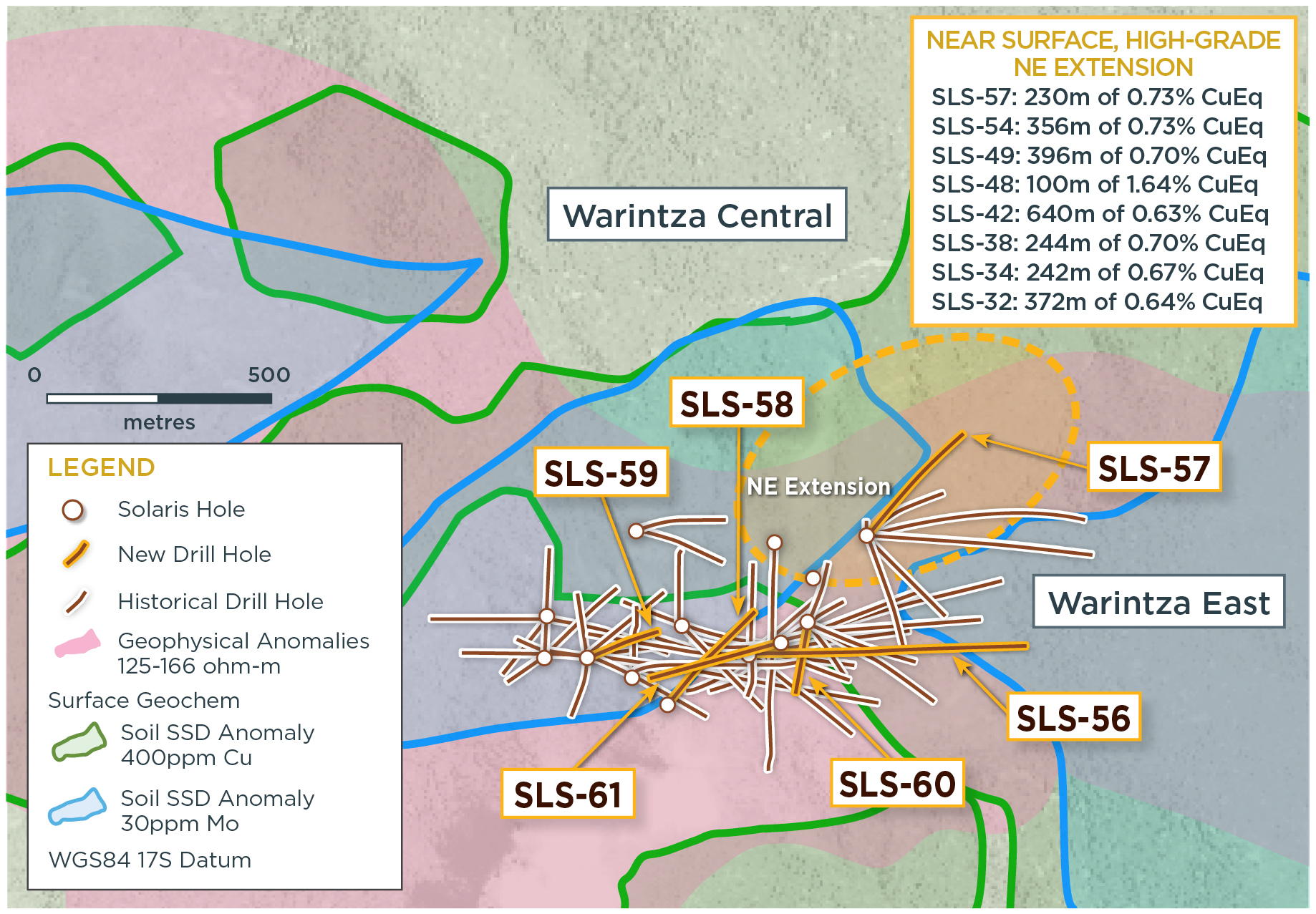
Table 1 – Assay Results
| Hole ID | Date Reported | From (m) | To (m) | Interval (m) | Cu (%) | Mo (%) | Au (g/t) | CuEq¹ (%) |
| SLS-61 | May 26, 2022 | 2 | 932 | 930 | 0.62 | 0.03 | 0.07 | 0.77 |
| SLS-60 | 44 | 873 | 829 | 0.50 | 0.01 | 0.04 | 0.58 | |
| Including | 70 | 224 | 154 | 0.81 | 0.02 | 0.05 | 0.90 | |
| SLS-59 | 2 | 513 | 511 | 0.54 | 0.04 | 0.07 | 0.73 | |
| Including | 34 | 272 | 238 | 0.67 | 0.03 | 0.08 | 0.85 | |
| SLS-58 | 102 | 843 | 741 | 0.48 | 0.03 | 0.06 | 0.62 | |
| SLS-57 | 0 | 926 | 926 | 0.49 | 0.02 | 0.08 | 0.61 | |
| Including | 56 | 286 | 230 | 0.59 | 0.03 | 0.08 | 0.73 | |
| SLS-56 | 48 | 606 | 558 | 0.33 | 0.01 | 0.03 | 0.38 | |
| Including | 48 | 150 | 102 | 0.80 | 0.02 | 0.04 | 0.90 |
Table 2 – Collar Location
| Hole ID | Easting | Northing | Elevation (m) | Depth (m) | Azimuth (degrees) | Dip (degrees) |
| SLS-61 | 800191 | 9648065 | 1573 | 967 | 255 | -72 |
| SLS-60 | 800258 | 9648097 | 1559 | 873 | 190 | -80 |
| SLS-59 | 799765 | 9648033 | 1571 | 513 | 65 | -70 |
| SLS-58 | 799942 | 9647932 | 1643 | 843 | 40 | -70 |
| SLS-57 | 800383 | 9648303 | 1412 | 964 | 40 | -71 |
| SLS-56 | 800126 | 9648032 | 1566 | 920 | 88 | -50 |
| Notes to table: The coordinates are in WGS84 17S Datum. | ||||||
Endnotes
- Copper-equivalence calculated as: CuEq (%) = Cu (%) + 4.0476 × Mo (%) + 0.487 × Au (g/t), utilizing metal prices of US$3.50/lb Cu, US$15.00/lb Mo, and US$1,500/oz Au, and assumes recoveries of 90% Cu, 85% Mo, and 70% Au based on preliminary metallurgical test work.
- Refer to press release dated February 28, 2022. Copper-equivalence calculated as: CuEq (%) = Cu (%) + 3.33 × Mo (%) + 0.73 × Au (g/t), utilizing metal prices of US$3.00/lb Cu, US$10.00/lb Mo, and US$1,500/oz Au. No adjustments were made for recovery prior to the updated Warintza Mineral Resource Estimate, as the metallurgical data to allow for estimation of recoveries was not yet available. Solaris defined CuEq for reporting purposes only.
- Refer to Solaris press release dated April 18, 2022, stating updated Warintza Mineral Resource Estimate.
Source: Solaris Resources
The above references an opinion and is for information purposes only. It is not intended to be investment advice. Seek a licensed professional for investment advice. The author is not an insider or shareholder of any of the companies mentioned above.
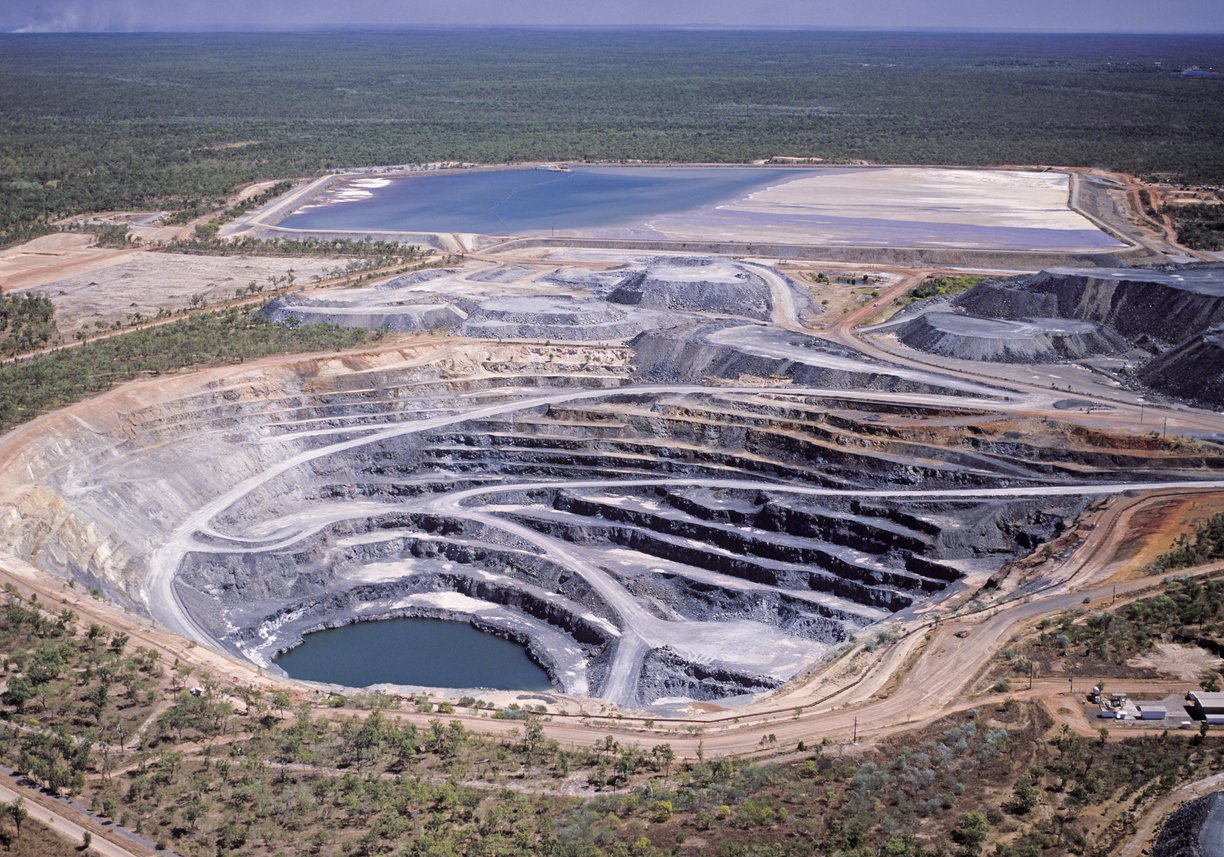
Kopore Metals (ASX:KMT) has announced that it has acquired a 100% stake in the highly prospective Agadez uranium project from Endeavour Finance. The project is located in the Tim Mersoi Basin, with three granted exploration permits currently. The project also has one exploration licence application in the Tim Mersoi Basin. Agadez sits in an area which is claimed to be one of the world’s major uranium-producing areas, making it a highly prospective project for the company.
Kopore managing director Caroline Keats commented in a press release: “The coming period is a very exciting time for the company, with an update of the Takardeit Mineral Resource in compliance with JORC 2012 Guidelines underway and drilling and soil sampling to commence immediately. We also have further exploration planned, which is expected to include geological and structural mapping, an airborne EM survey (VTEM) and an extensive mud rotary drilling programme. We look forward to advancing Agadez with the aim of capitalising on the increasing demand for nuclear fuels, as the world continues to shift towards a decarbonised energy system.”
Kopore Metals has issued 120 million shares, 80 million performance shares, on top of 50 million performance share options to Endeavour Finance for the binding sale agreement. The performance shares and options stipulate that a mineral resource estimate of a minimum 16Mlb of U₃O₈ on at least one of the permits must be confirmed.
First stages for the project include drilling and soil sampling, followed by a complete drill and exploration program beginning immediately. The exploration includes geological and structural mapping at Agadez, with an airborne EM survey, diamond hole drilling, and includes a mud rotary drilling program.
The Agadez uranium project in the West African nation of Niger was granted a two-year extension for the exploration permits at the end of March. Kopore ill spend US$2 million on the permits just in the first two years of the agreement, with a total of US$1.5 million planned to be spent on drilling.
The company is betting that the historical dataset will be a valuable resource for exploration. Instead of starting from scratch, the company can focus in on priority targets as identified by the historical data, and reduce exploration costs throughout the drill program.
Since 1971, Niger has produced approximately 1,450,000 tonnes of uranium, making it the world’s current sixth largest producer. Niger as good infrastructure as well, with Agadez sitting near an international airport, giving the project excellent economic prospects.
Uranium mining is a significant contributor to Niger’s economy, with the majority of the country’s mining exports being uranium ore. The Agadez project is expected to bring in more revenue for Kopore and contribute to the constantly growing uranium industry in Niger.
The above references an opinion and is for information purposes only. It is not intended to be investment advice. Seek a licensed professional for investment advice. The author is not an insider or shareholder of any of the companies mentioned above.
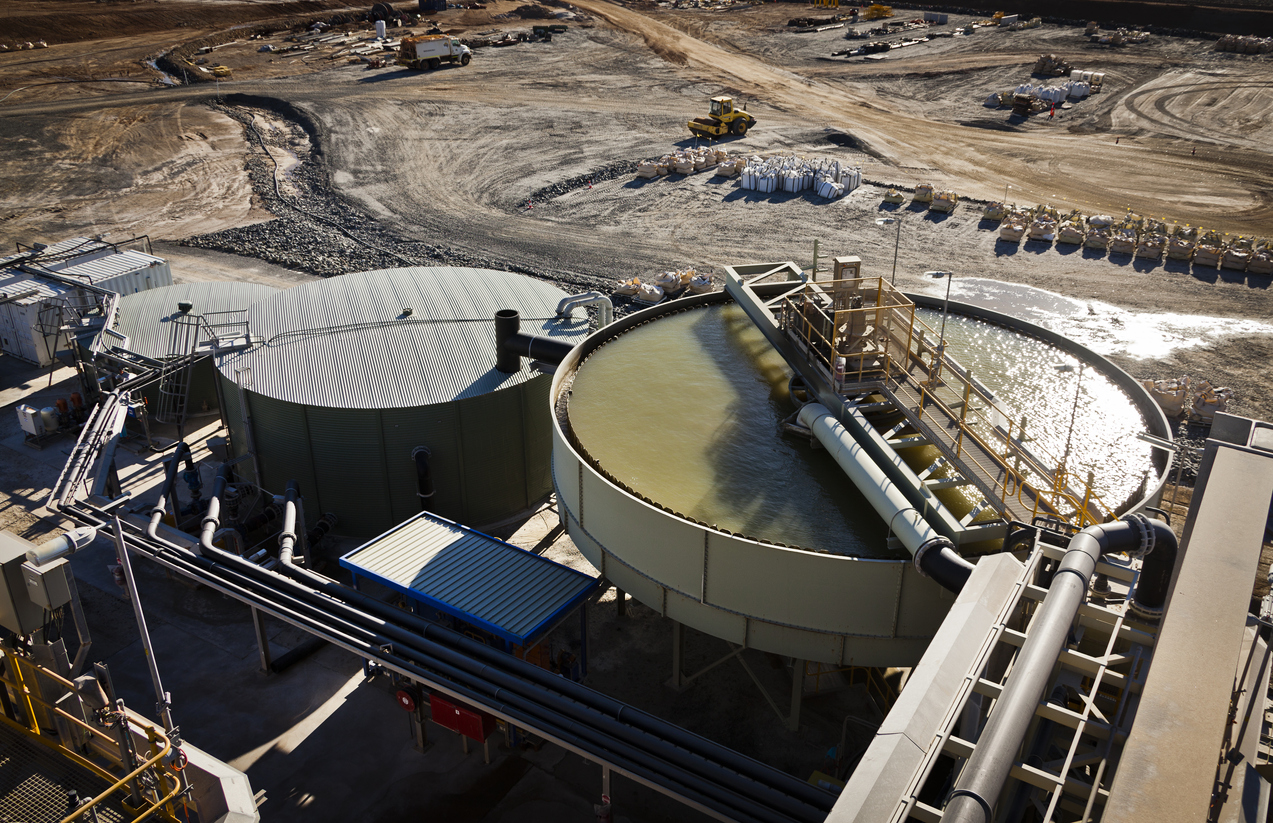
AVZ Minerals Ltd. (ASX:AVZ) is currently trying to maintain control of the Manono Lithium Project, possibly the largest untapped lithium deposit in the world. Chinese investors have claimed ownership of the project, which would drop AVZ’s share of the project to 36% from its current 75% stake. The Manono project is located in the Democratic Republic of Congo. The company is planning a sale of 24% of the project in May, while other companies including Zijin Mining Group Co. claim ownership.
According to Friday’s statement from AVZ, the company has extended its voluntary suspension of trading on the ASX until June 1, waiting for the Congolese government to complete permit approvals for Manono. With a market capitalization of about A$2.75 billion ($1.9 billion), AVZ had risen by more than 400% in the previous year.
Lithium is an important material for electric-vehicle batteries. The price of lithium has multiple by 400% in the past twelve months, with prices only recently stabilizing during restrictions in China that have hampered manufacturing.
The Manono project is just one of many battles being fought over Africa’s vast mineral resources. Chinese companies have been on a spending spree in recent years, acquiring mining assets around the world. Congo has been a flashpoint for many projects, with the central African country being the largest producer of cobalt in the world. The country also has some of the biggest lithium deposits, making Congo a battery metals hotspot for mining companies around the world. Chinese companies are estimated to control approximately 50% of the country’s cobalt output and over 70% of copper production.
Now, AVZ is just days away from securing a mining permit for the project according to the company. However, shortly after announcing that, the company announced that Jin Cheng Mining Company Ltd., a subsidiary of Zijin, requested arbitrations at the International Chamber of Commerce in Paris.
The company says it will claim a 15% share of the project previously acquired from Congo’s state-owned mining company Cominiere in 2021. The claim must now be heard by the Chamber, and will likely be followed by litigation and further lawsuits. Boatman Capital has published a report in which a contract showing Jin Cheng did agree to pay $33.4 million to Cominiere for the 15% stake was signed. However, AVZ’s claim is that the agreement is moot because the company holds the right to preempt share sales of the project by Cominiere. Cominiere holds 25% of the project, but now AVZ is discussing acquiring the 15% stake from Cominiere.
Part of the lawsuit will hinge on the price of the deal. In a previous agreement, Chinese battery maker Suzhou CATH Energy Technologies agreed to buy 24% of the project from AVZ for $240 million, representing almost five times the value per share versus the Cominiere and Jin Cheng deal.
China’s mining companies have increasingly looked outside its borders to invest in metals and minerals needed to fuel its manufacturing sector. However, these companies have often been accused of unfair business practices, such as acquiring assets through convoluted ownership structures and paying below-market prices for resources. These accusations have led to increased scrutiny from host countries and government officials.
The battle for the Manono project is just one example of the challenges some Chinese companies are facing with challenges to stakes in projects in Africa and South America.
The above references an opinion and is for information purposes only. It is not intended to be investment advice. Seek a licensed professional for investment advice. The author is not an insider or shareholder of any of the companies mentioned above.
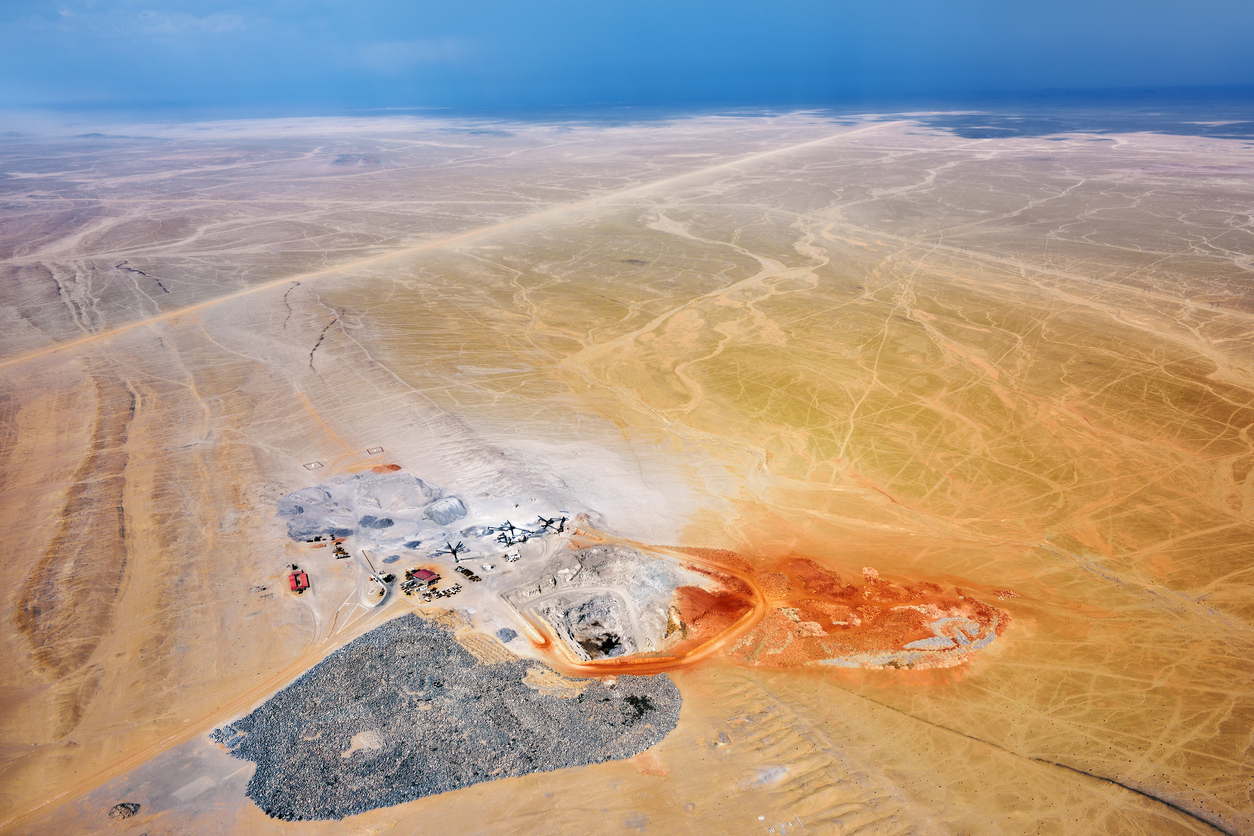
Bannerman Energy (ASX:BMN), an Australian uranium company, has purchased a 41.8 percent stake in Namibia Critical Metals (NMI), which owns a portfolio of critical metals projects in Canada and Namibia. The A$7.24 million cash deal also includes 8,463,367 Bannerman ordinary shares after it purchases 82,290,680 shares of NMI from PhilCo 192 major shareholder Adventure Resources. The core asset in Namibia for NMI is the 95% owned fully permitted Lofdal Heavy Rare Earths project. The project’s other 5% stake is also held for the benefit of historically disadvantaged Namibians.
Bannerman managing director and CEO Brandon Munro commented: “The Lofdal Project is on a path to produce dysprosium and terbium, two of the most strategically important metals on the planet. Our exposure to this future production, through a strategic shareholding in Namibia Critical Metals, is therefore a strong fit with Bannerman’s Etango Project, a near-term supplier of uranium at a globally significant scale.”
The acquisition of NMI also helps Bannerman align another key project in Namibia, the advanced-stage Etango tantalum-niobium-uranium project with infrastructure and other synergies. Bannerman has focused in recent years on social leadership and other ESG goals, and the heavy rare earths industry has become a particular focus as it is a key enabler for the clean energy transition.
Heavy rare earths have become increasingly important in recent years as they are used in a variety of high-tech applications, including electric vehicles, wind turbines, and lasers.
Namibia Critical Metals president and CEO Darrin Campbell also commented: “I expect that Bannerman’s development experience, plus downstream industry and broader marketing experience, will be highly advantageous as we progress Lofdal towards being a globally significant supplier of dysprosium and terbium to the burgeoning permanent magnets sector.”
While Namibia is a producer of heavy rare earths, other countries like China have dominated the market in recent years. The country has been gradually reducing its exports of rare earths in an effort to secure supplies for its own growing high-tech industry.
This strategy is of particular worry to the global high-tech industry as China is currently the source of more than 80% of the world’s rare earths supply. Prices for rare earths have soared in recent years as a result of China’s export restrictions, and projects outside the country have gained importance and value as well.
The above references an opinion and is for information purposes only. It is not intended to be investment advice. Seek a licensed professional for investment advice. The author is not an insider or shareholder of any of the companies mentioned above.
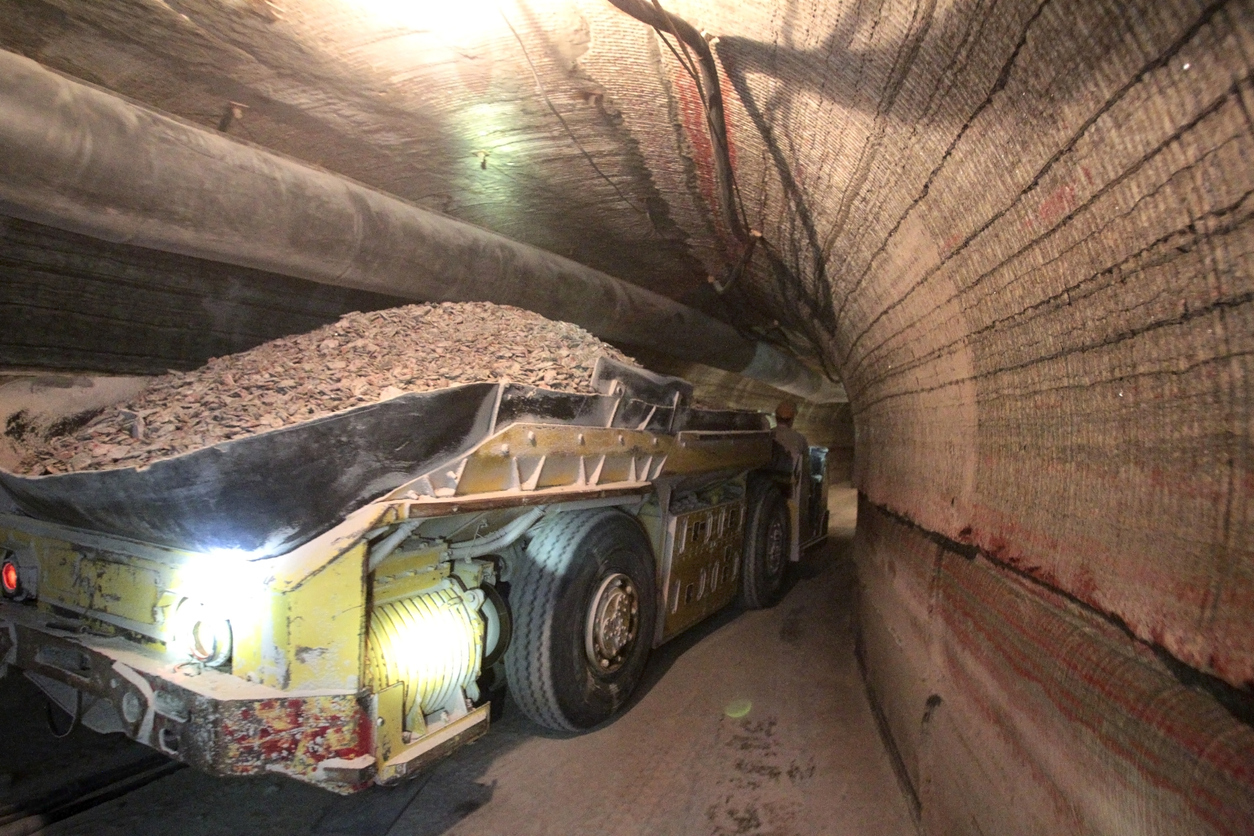
BHP (ASX:BHP) is looking to its Canadian potash project to mitigate current and future risks to global fertilizer supplies due to the Russian conflict. The company’s $5.7 billion Jansen potash project in Canada is set to be accelerated with Stage 1 first production being pushed to 2026. This is an acceleration of a full year as the company had planned to begin production at the project in 2027. The war in Ukraine has hit supplies of important grains, as well as fertilizers. This is because Russia and Belarus currently account for 40% of global production, and the instability, as well as actions, have cut off supply.
In the middle of February, Belarusian state-owned potash miner Belaruskali sparked concerns by announcing force majeure on its contracts. This alarmed a market that was already struggling with skyrocketing prices. Since then, further sanctions on Russia have worsened the situation, cutting off supplies.
BHP CEO Mike Henry is now looking to the company’s Canadian project, located in a politically and geographically stable mining jurisdiction. This would reduce the supply-side disruption risks. Henry spoke about this at the Bank of America Metals and Mining conference earlier this week: “[Supply-side disruption linked to the war in Ukraine] has positively reinforced the decision we’ve taken to enter potash. We are making good progress and we’re looking at potential to accelerate Jansen Stage 1 first production into 2026.”
Potash is expected to be produced in Jansen at a rate of about 4.2 million tonnes each year during the first phase. Stage 2 would produce an additional 4 million tonnes every year, for a capital intensity of between $800 and $900 per tonne, nearly 30% lower than the planned costs for Stage 1.
Now, the company has begun studies for a second phase of the project’s development, which could advance things faster. With the $5.7 billion investment, BHP had given roughly $1.4 billion in contracts as of late April and an additional $200 million since the firm released first-half results in February, which cover port infrastructure, underground mining systems, and other shaft and surface construction projects.
“If we decide to bring on all four stages, and at prices just half of where they are today, we’d be generating around $4 billion to $5 billion of EBITDA [earnings before interest, depreciation, tax and amortisation] per year,” Henry said at the conference.
Potash shortages are a concern not just for the mining industry but for agricultural industries. Potash is valuable to farmers because it can be used as fertilizer. Fertilizers boost crop yields, which is important for food security. The current situation with Russian supplies has led to higher prices and could create food shortages.
BHP’s move to accelerate its Jansen project is a response to this potential crisis. By increasing production, the company can help to offset any potential disruptions in supply and ensure that farmers have access to the potash they need. With the potential to produce 17 million tonnes per year with the four phases of development, the single Canadian project would account for approximately 25% of the global demand for potash.
Current supply chain issues could take three years to resolve due to the current situation, and the company is moving quickly to shore up its projects and resources for the future.
The above references an opinion and is for information purposes only. It is not intended to be investment advice. Seek a licensed professional for investment advice. The author is not an insider or shareholder of any of the companies mentioned above.
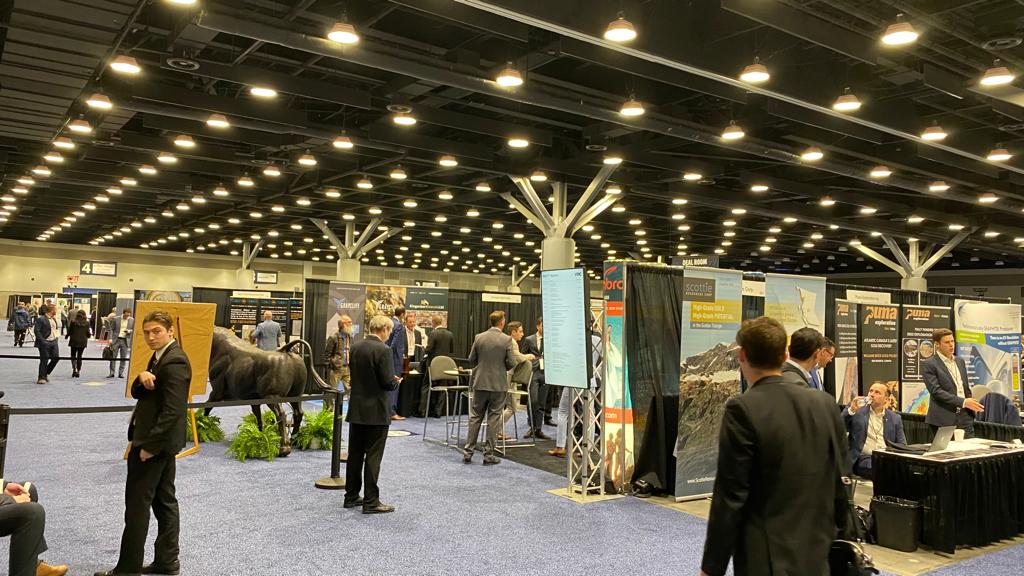
Collective Mining (TSXV:CNL) will participate in several upcoming virtual and in-person conferences, giving investors and potential investors the opportunity to learn more about the company’s progress at its Guayabales and San Antonio projects in Colombia. The company has also launched a new website design at https://collectivemining.com, with an intuitive and informative layout for investors to learn more about the company and get in touch.
Management will discuss a range of topics including its ongoing 20,000+ metre drill program that has so far yielded three discoveries from four targets, with visual encouraging intercepts from a fifth target.
The company most recently announced that it had expanded the Olympus Target discovery holes with high-grade vein systems and reported channel sampling of 221 g/t gold, and 812 g/t silver. Ongoing drilling at Guayabales includes three diamond drill rigs turning at the Olympus, Apollo, and Trap targets.
Upcoming Conferences
121 Mining Investment, New York, NY – June 6-7, 2022 – Investors may sign up here to register and arrange a meeting with Company management.
PDAC, Toronto, ON – June 13-15, 2022 – Investors may register here and visit the Company at booth 2714.
Source: Collective Mining
The above references an opinion and is for information purposes only. It is not intended to be investment advice. Seek a licensed professional for investment advice. The author is not an insider or shareholder of any of the companies mentioned above.
KORE Mining Ltd (TSXV:KORE) has announced that a gold stream sediment sample of 9.98 grams per tonne has been collected at its Powerline target area in the Imperial Gold Project. After doing extensive follow-up work, a 45-acre gold anomaly was established with 600 meters of strike a Powerline positioned between two outcrops of mineralized gneiss. This is the same host rock type of the Imperial deposit.
KORE’s Executive Chairman, James Hynes, commented in press release: “The exploration potential of the Mesquite-Imperial-Picacho trend is one the best exploration opportunities in the Western US gold fields. Our team has done an incredible job prospecting this huge area and we are seeing the potential we expected when we assembled the claim area over the last several years. There is much more to come, and we look forward to turning drills on the best targets in the near future.”
The company has also highlighted a total strike potential of the Powerline trend to over 5 kilometres, and a 0.77 g/t gold stream sediment sample that was collected from the Ogilby target areas, which established a new priority drill target where drill permitting is already in progress.
Highlights of the results are as follows:
- 9.98 g/t gold (“Au”) stream sediment sample collected at Powerline target area.
- Additional sampling yielded a 600-meter trend of highly anomalous stream sediment samples.
- Trend situated between two mineralized gneiss outcrops: the Powerline discovery outcrop and Ironwood outcrop.
- Large, shallow geophysical anomaly similar to the Imperial deposit aligns with the trend.
- 0.77 g/t Au stream sediment sample collected within Ogilby segment boundary, an area with drill permitting in progress.
KORE has defined five prospect areas for the exploration areas west of Imperial towards the Mesquite gold mine (“Mesquite”) owned by Equinox Gold (TSX: EQX). This release summarizes the geologic setting of the new high-grade samples collected at the Powerline and Ogilby targets, and the proposed follow up work along the trends. The five western prospects include Mesquite East and Ogilby which are currently being permitted for drilling (see news release May 12, 2022), Powerline, Smoketree and Ironwood.
In total, the Company has nine highly prospective drill targets identified in the overall Mesquite-Imperial-Picacho District (“District“) that captures 28 kilometers (“km”) of prospective ground from Mesquite to the historic Picacho gold mine (“Picacho“). The four target areas east of Mesquite are described in KORE’s news release from April 26, 2022.
KORE is committed to operating within the stringent environmental and labour standards of California. Exploration drilling is designed to avoid any sensitive areas and all land disturbances will be rehabilitated.
Figure 1 shows the geologic map of the Powerline and Ogilby target areas, the locations of associated prospects, and anomalous gold assays from stream sediment and rock chip sampling.

Figure 2 shows the georeferenced induced polarization (“IP”) geophysics sections intersecting the Powerline and Ogilby target areas, and mentioned subsurface anomalies.

Figures 3 shows a photo compilation of prospective areas at Powerline, gold flakes and nuggets discovered at the site of the 9.98 g/t Au sample, and the person-portable drilling apparatus in use at the Powerline area.

Powerline Target Details
The Powerline target area now consists of four known outcrops/subcrops of mineralized gneiss and has a spatial footprint of over 1300 acres (3.7 km by 2.5 km). The 9.98 g/t Au sample was collected in between two known altered gneiss outcrops referred to as the Powerline discovery and Ironwood Outcrops (Figure 1). In between these outcrops, the overlying Tertiary Bear Canyon conglomerate has strong localized alteration in a style similar to the alteration observed at the Imperial deposit. Follow up sampling and mapping efforts have established a 600m trend of strongly anomalous gold mineralization (Figure 1), with fine gold flakes and nuggets present in shallow stream beds (Figure 3). The location of the high-grade trend, as well as the prevalence of coarse gold, indicates that the mineralizing system is strong and the host rock is near surface along trend.
The Powerline discovery outcrop is interpreted as two WNW-ESE trending thrust sheets which bring crystalline basement host rocks to the surface, analogous to the geologic setting of the Imperial deposit. Topographically, Powerline has a distinct signature referred to as a “turtleback” feature. All Powerline area prospects were discovered within this topographic anomaly. The prospect areas are namely the Powerline discovery outcrop, Ironwood outcrop, and Smoketree subcrop. Each prospect consists of strongly brecciated and altered gneiss along two distinct east to west trends of mineralization.
A property-wide multispectral WorldView-3 alteration mapping survey conducted in 2021 greatly accelerated the rate of new discoveries in the Powerline target area. This imagery highlighted areas of chlorite alteration, which directed mapping and reconnaissance efforts to the site of the 9.98 g/t Au sample. The intact Imperial deposit was used to establish the alteration fingerprint of the mineralizing system, which has since been identified in over 11 other areas within the project boundaries.
Additional evidence of mineralization is provided by four IP survey lines, which intersect the Powerline target area and indicate the presence of a large anomaly within the subsurface (Figure 2). Similar to the multispectral satellite data, the intact Imperial deposit was used to calibrate the 2021 IP dataset, significantly increasing the confidence level of these interpretations.
Following the 9.98 g/t Au sample result, additional mapping and sampling is scheduled for Q2 – Q3 2022. Furthermore, a fully permitted person-portable drilling program will be executed within the Powerline target area. This drilling system produces BQ sized core samples up to 30 ft depth and will be critical in interpreting the subsurface geology in areas covered by the Bear Canyon conglomerate.
Source: KORE Mining Ltd.
The above references an opinion and is for information purposes only. It is not intended to be investment advice. Seek a licensed professional for investment advice. The author is not an insider or shareholder of any of the companies mentioned above.
Solaris Resources (TSX:SLS) has had the highest insider buying for its industry group, leading all issuers in the TSX materials sector, and that rate continues to climb. The company has announced that it received about C$30.4 million from the exercise of common share purchase warrants. The company is now fully funded through to mid-2023 for its drill program at the Warintza Project in Ecuador.
Mr. Daniel Earle, President & CEO, commented in a press release: “With last year’s intensive resource drilling program at Warintza Central having established a voluminous mineral resource estimate and robust starter pit, we are now directing our efforts to immediate high-impact drilling aimed at expanding the starter pit in open extensions of near surface, high-grade mineralization at Warintza Central, expanding the minimally-drilled Warintza East discovery, and testing the potential of the nearby Warintza West discovery.”
The total insider buying has now crossed $170 million dollars in the past 24 months, as a portion of the warrants has been exercised by Solaris management. Executive Chairman Richard Warke is the main shareholder exercising the most warrants. In the second half of 2022 and the first half of 2023, more warrant expires will occur. Should holders choose to exercise all of them, the company would bring in another C$54.1 million, with approximately 63% of the still outstanding warrants held by management.
A recent mineral resource update for Warintza Central showed in-pit resources of 579 Mt at 0.59% CuEq (Ind) and 887 Mt at 0.47% CuEq (Inf). This also includes an ‘indicative starter pit’ of 180 Mt at 0.82% CuEq (Ind) & 107 Mt at 0.73% CuEq (Inf). Additionally, the company is now targeting high-grade extensions and major growth in cluster. Warintza East and Warintza West will now become the focus for the company as it advances its flagship project.
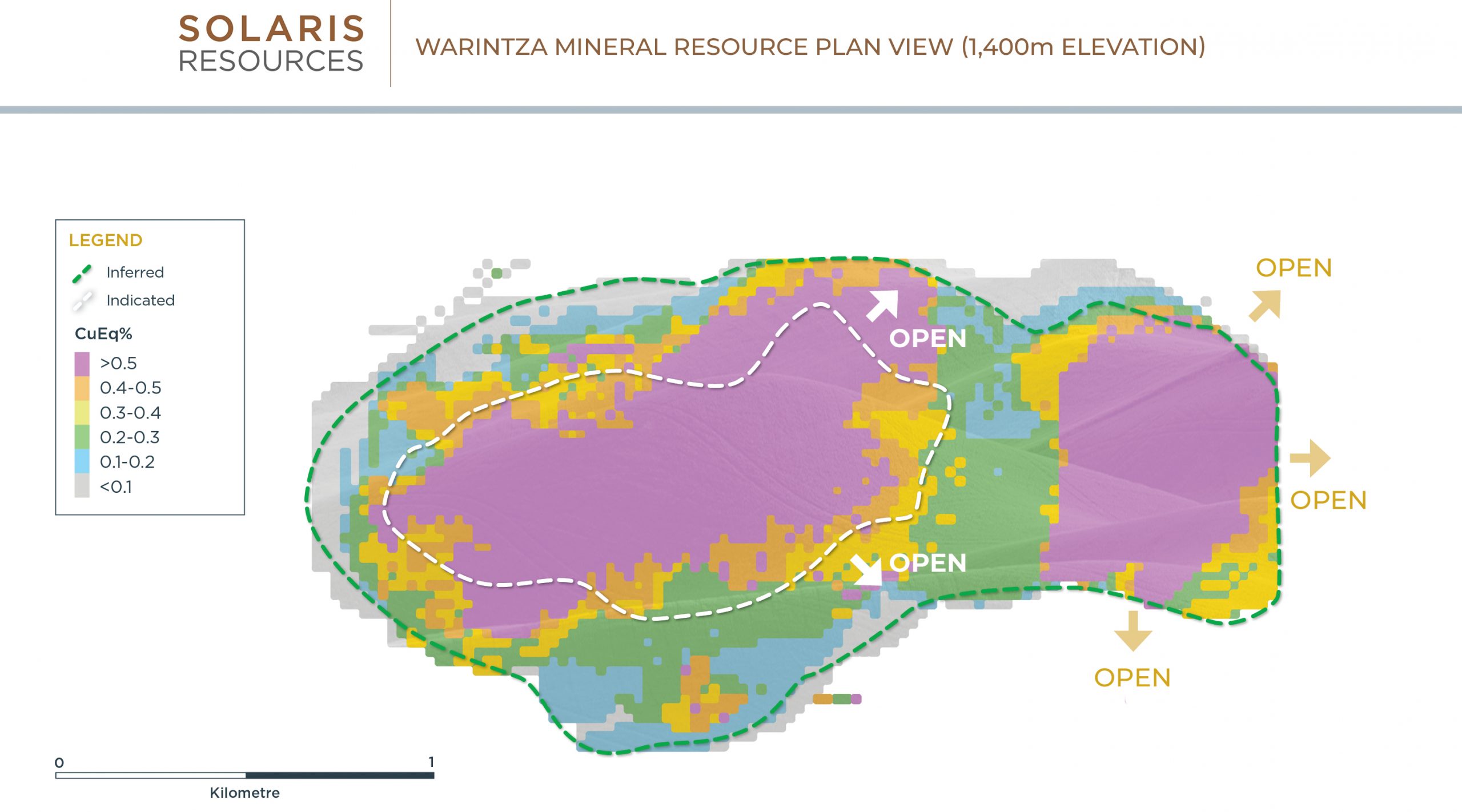
Highlights from the Warintza Central mineral resource update are as follows:
- In-Pit Indicated mineral resources of 579 million tonnes (“Mt”) at 0.59% copper equivalent¹ (“CuEq”) and Inferred mineral resources of 887 Mt at 0.47% CuEq¹ above a 0.3% CuEq cut-off grade
- Includes ‘Indicative Starter Pit’ comprised of Indicated mineral resources of 180 Mt at 0.82% CuEq² and Inferred mineral resources of 107 Mt at 0.73% CuEq² above 0.6% CuEq cut-off grade
- High Quality – Expected low strip ratio ‘Indicative Starter Pit’ and ultimate pit, zoned from high-grade at surface to low grade at depth, consistent, clean sulphide mineralogy free of deleterious elements
- High-Grade Growth – Ongoing drilling focused on open extensions of near surface, high-grade mineralization to the northeast and southeast of Warintza Central
- ‘Super Pit’ Growth – Warintza Central pit shell includes overlapping portion of Warintza East, discovered mid-2021, a target wide open for major growth potential within a shared pit
- Cluster Potential – Warintza Central forms part of a 7km x 5km cluster of porphyry deposits, where in addition to East, recent discoveries at West and South offer major growth potential
- Structural Advantages – Set within mining district featuring access to highway, abundant and low-cost hydroelectric power, fresh water, labour and low elevation
Source: Solaris Resources
The above references an opinion and is for information purposes only. It is not intended to be investment advice. Seek a licensed professional for investment advice. The author is not an insider or shareholder of any of the companies mentioned above.
Collective Mining (TSXV:CNL) has announced sample assay results from its grassroot-generated Olympus target at the Guayabales project in Colombia. Results showed high-grade gold and silver high-grade vein systems, with channel sampling up to 221 g/t gold and 812 g/t silver. Results come from ongoing drilling at Guayabales where the company has three diamond drill rigs turning at the Olympus, Apollo, and Trap targets. The current results expand on the recently announced discovery holes at Olympus of 302 metres at 1.11 g/t gold equivalent and 216.7 metres at 1.08 g/t gold equivalent.
Highlights from the results are as follows:
Assay results of chip channel samples taken from veins located within historical, shallow underground workings from Olympus confirm the continuation of the high-grade carbonate base metal (“CBM”) sheeted vein system into the southwest portion of the target area with results as follows:
Table 1: Chip Channel Sample Assay Results from Olympus
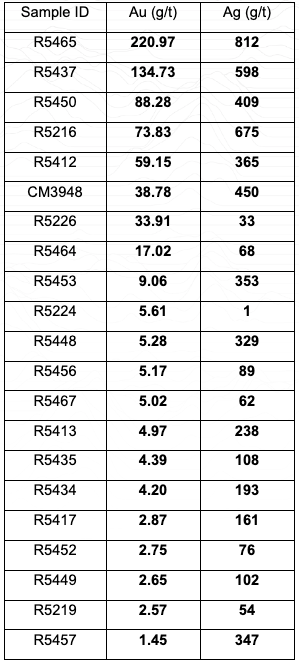
*Channel chip samples reported above are over true horizontal sampling widths of between 0.1 and 1 metre. Sample grades are uncapped
**Channel samples are representative of 2-dimensional space and as a result should not be relied upon as being representative of average grades anticipated in any future resource estimate or mining scenario.
***Assay results for base metals are still pending for all samples listed.
- Multiple CBM veins were sampled, where possible at Olympus, over an area measuring 250 metres x 250 metres from limited and partial exposures of rock in old tunnels. The CBM veins are sulphide rich and associated with intense sericite-illite alteration superimposed on porphyry diorite and mineralized, hydrothermal breccia. Porphyry-related CBM veins can demonstrate robust continuity over significant vertical and lateral dimensions.
- Drilling, underground sampling and surface mapping to date have expanded Olympus to a target area measuring more than 1,400 metres by 900 metres, which hosts over 50 artisanal mines with over 25 veins mapped from available exposures. The Company believes that the probability is high that additional veins will be discovered as exploration ramps up. The Olympus target is open to the east, west, northwest, south and at depth.
- Olympus now includes two mineralized zones. Both zones contain multiple porphyry and overprinting CBM veins associated with intense pyrite-sericite-carbonate alteration and hosted in a porphyry diorite (Eastern zone) and within schist country rocks intruded by porphyritic diorite (Western zone).
- The highest-grade samples collected to date at Olympus come from areas that have yet to be drill tested by the Company. Diamond drilling completed to date has only focused on a small northern portion of the Eastern and Western zones while recent surface and underground mapping has expanded the Western zone to the west and southwest.
- The Company is planning to move two underground rigs in Q2 into the area covered by these high-grade channel sampling results.
“With the scale of veining and alteration at Olympus and mineralized systems that come to surface, the Company now believes that we have a discovered a vein and broad mineralized system,” commented Ari Sussman, Executive Chairman. “The more exploration we undertake, the more high-grade veins we find. We will remain aggressive with drilling at Olympus and look forward to commencing the first underground drill-hole into the high-grade vein portion of the system in June 2022.”
Figure 1: Plan View of the Guayabales Project and the Olympus South Target
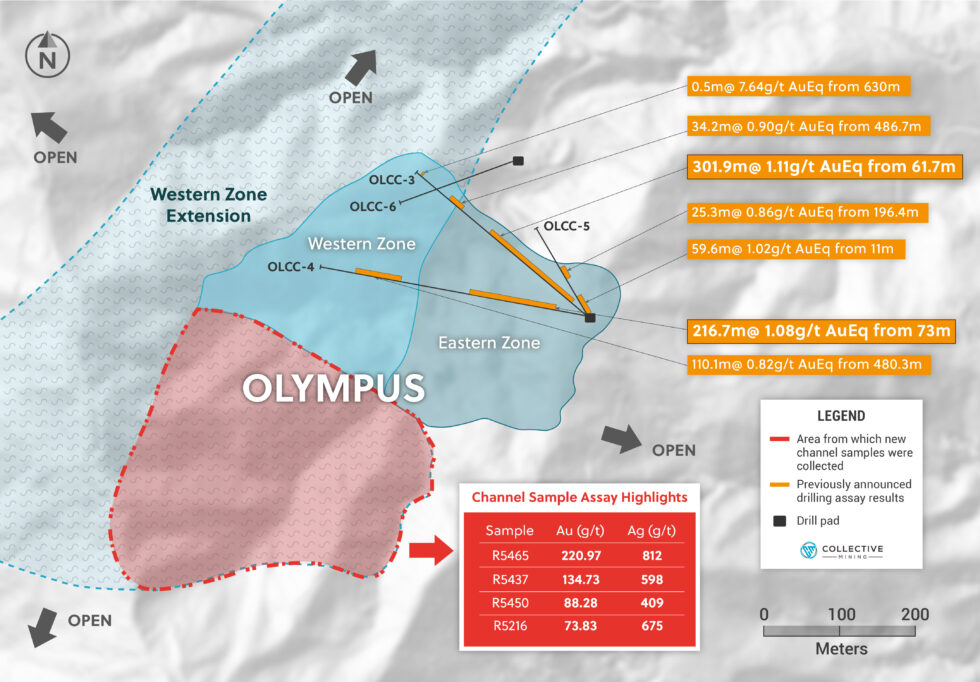
Figure 2: Photos of High-Grade Polymetallic Grab Samples Taken at Olympus
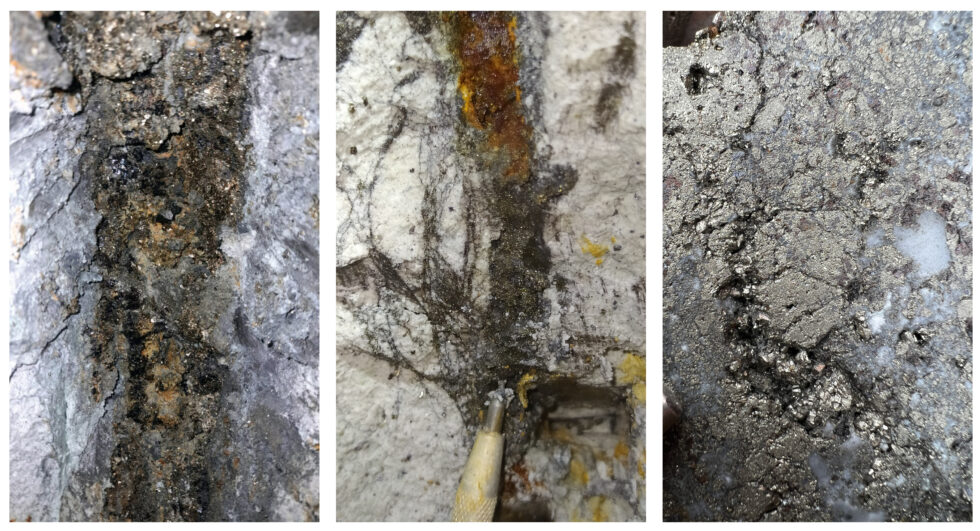
The above references an opinion and is for information purposes only. It is not intended to be investment advice. Seek a licensed professional for investment advice. The author is not an insider or shareholder of any of the companies mentioned above.
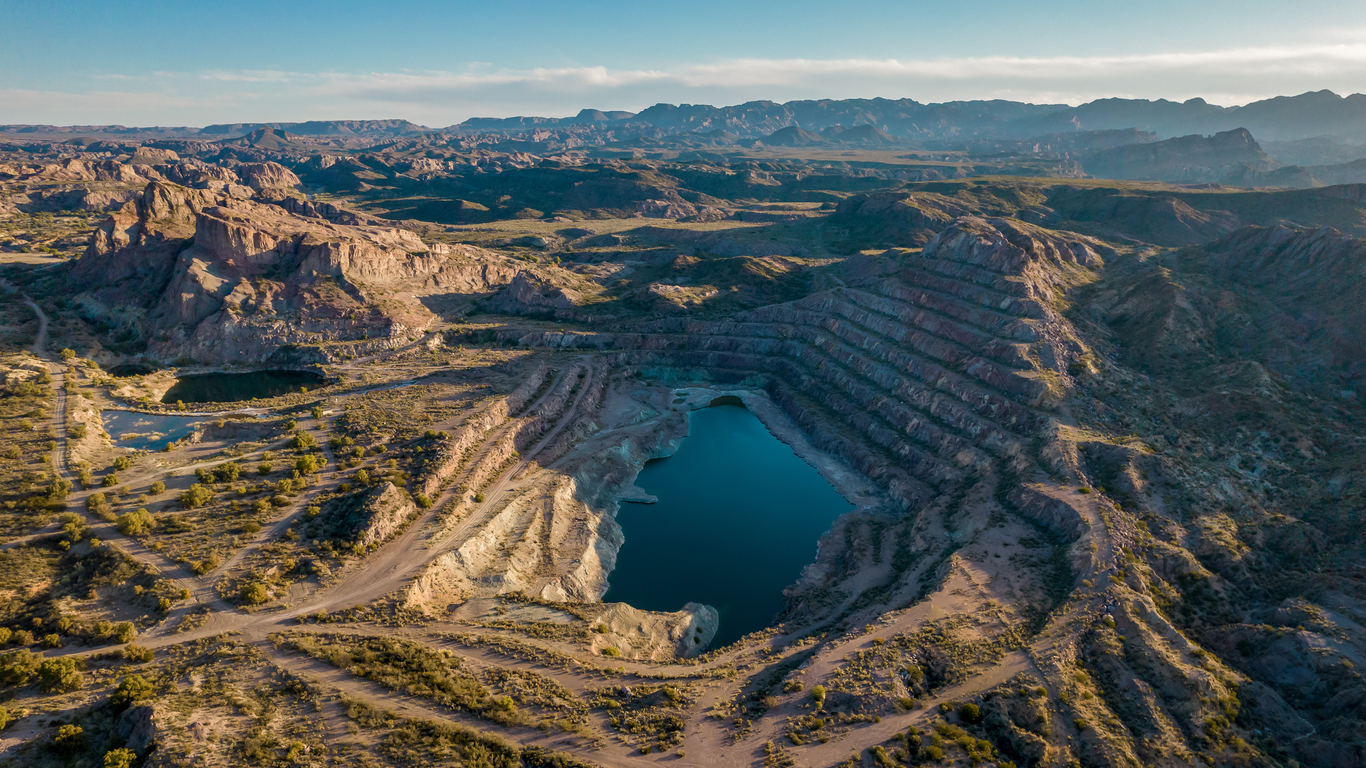
The Mogote copper-gold project in Argentina, owned by Golden Arrow Resources (TSXV:GRG), will be optioned up to 85% to Syndicate Minerals. The Australian mineral exploration company will have the option to earn an 85% interest in the Mogote project, which has already undergone 12,000 metres of drilling. An Argentinean subsidiary of Golden Arrow Resources will sign the agreement.
Golden Arrow has been looking to develop secondary value streams, and joint venture projects like this one from its 180,000-hectare property portfolio in Argentina portfolio are one way of doing that. Joseph Grosso, executive chairman, president, and CEO of Golden Arrow Resources, commented: “We look forward to this partnership with Syndicate to advance Mogote, providing another excellent opportunity for us to build value for our investors at no cost to us. Our previous success at Chinchillas left us strongly funded for exploration without further dilution to our shareholders and our team is focused on repeating that achievement at our new 100% held San Pietro copper project in Chile while continuing to advance our other core projects through our five-step exploration process.”
Syndicate Minerals will need to spend $5 million on exploration in the following five years and pay $1.9 million in additional cash for the period to earn an initial 80% interested in the Mogote Project. This option earn-in is the first step, to be followed by the option to complete a feasibility study for the additional 5% of the project. Golden Arrow Resources and Syndicate Minerals will form a joint venture company, which will be responsible for advancing the Mogote project. Some provisions for dilution have been made.
Mogote
The project holds over 8,000 hectares in the northwest San Juan province of Argentina, where 12,000 metres of drilling have already been completed. The project contains several areas of high-grade mineralization with potential for open-pit mining operations. A number of geophysical anomalies have been identified as well that are yet to be drill tested. It holds potential for multiple porphyries and epithermal targets which would be valuable to the project and both companies.
Golden Arrow has also initiated drilling at the Libanesa project, which will drill up to 2,000 metres in holes from 75 to 250 metres in d depth. The company’s other projects also include Cerro Redondo, Legunita, and Lagunita West, where testing will begin shortly
Copper porphyries are commonly found in the Andes mountain range. They are large igneous intrusions that contain high levels of copper and other valuable metals. Epithermal deposits are another type of target that is often found in the same region as porphyries. These are hot springs that can leave behind high-grade mineralization, including gold and silver.
The above references an opinion and is for information purposes only. It is not intended to be investment advice. Seek a licensed professional for investment advice. The author is not an insider or shareholder of any of the companies mentioned above.
Novo Resources (TSX:NVO) has reported assay results from the diamond drilling program on RL006587 at the Malmsbury Project in Victoria, Australia.
Novo exercised its option over the Malmsbury Project to acquire a 50 percent stake and the right to earn an extra 10 percent interest by investing A$5 million in exploration costs over the following four-year period. The company’s results follow up on early success from the first 3 drill holes of the program, and confirm high potential for mineralization extension.
Ms. Kas De Luca, General Manager of Exploration at Novo Resources, commented in a press release: “These preliminary, high-grade results from the Malmsbury Project are very promising. Following the early success and results from the first 3 holes of this drill program, further work to confirm potential for mineralization extension, including IP and additional drilling, are planned for 2022 and early 2023. We look forward to working with our partner, GBM, to continue advancing the exciting potential of the Malmsbury Project.”

Highlights from the results are as follows:
- Drilling on the 50%-owned Malmsbury gold project (“Malmsbury Project”) joint venture with ASX-listed GBM Resources Ltd. (“GBM”), located 50 km SSW of the high-grade Fosterville gold mine in Victoria, Australia, has intersected a significant high-grade gold mineralized zone.
- Significant results received to date include 14 m @ 6.1 g/t Au from 120 m, 10 m @ 4.9 g/t Au from 173 m and 4 m @ 8.6 g/t Au from 188 m (MD16); 7.8 m @ 3.6 g/t Au from 32.2 m (MD13); and 9.1 m @ 2.4 g/t Au from 65.4 m (MD14). These results are not necessarily representative of mineralization throughout the Malmsbury Project. Remaining assays for the program are expected over the coming months.
- 2,000 m of diamond drilling completed (>75% of program) with full gold and multi-element assays received from the first three of six holes completed and sampled to date. Assays confirm high-grade shoot potential and splay features on the Leven Star mineralization and extension potential for the Missing Link Reef.
- Intersection of altered, quartz veined, and sulphide bearing Missing Link Monzogranite confirmed in drill hole MD17, from 204 m to 269 m. Drilling confirms a steep (70 – 80°) east-dipping elongate body that widens at depth and validates the potential for an intrusion hosted and/or intrusion related gold (“IRG”) system at the Malmsbury Project. Full gold and multi-element assays for MD17 are still pending at this time.
- Missing Link Monzogranite target now defined over 340 m strike and 40 m width (at surface) and remains completely open at depth.
- Current diamond drilling phase nearing completion (Q3 2022), with recent success to drive a larger second phase of diamond drilling later in 2022 or early 2023.
- 2D/3D induced polarization (“IP”) survey planned to help define sulphide rich granite-related targets and disseminated sulphide haloes around gold reef targets.
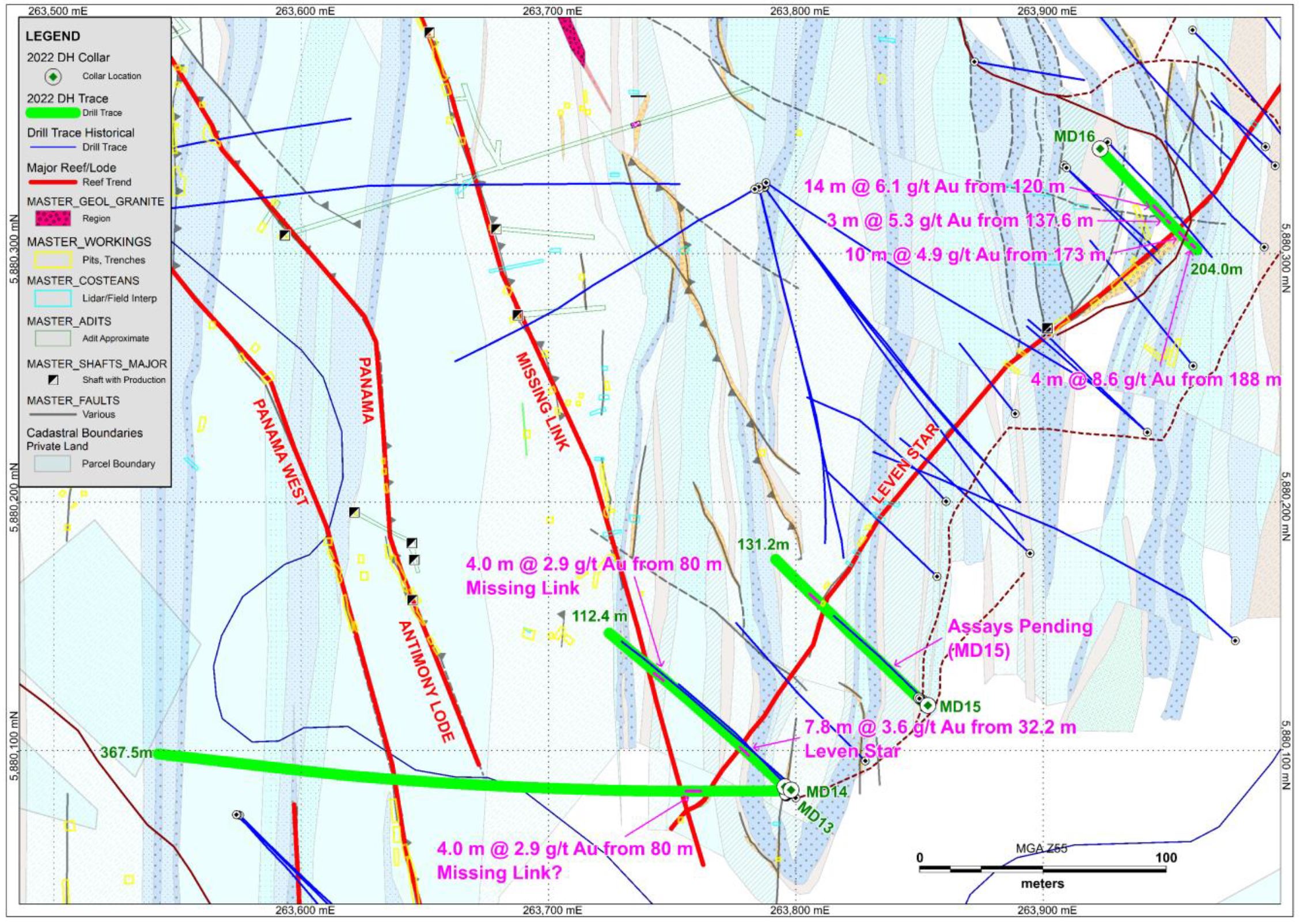
DETAILS of Drilling Program 2021 – 2022
Approximately 2,000 m (7 holes, 1 in progress) of a circa 2,650 m planned diamond drilling program have been completed to date at the Malmsbury Project. At the time of writing, gold, and multi-element assays from three of six holes completed have been returned in full. Significant results from these early holes are highly encouraging and include, but are not limited to:
- 14 m @ 6.1 g/t Au from 120 m; including 3 m @ 11.1 g/t Au from 131 m (MD16)
- 10 m @ 4.9 g/t Au from 173 m; including 7 m @ 6.8 g/t Au from 175 m (MD16)
- 4 m @ 8.6 g/t Au from 188 m (MD16)
- 7.8 m @ 3.6 g/t Au from 32.2 m; including 1.85 m @ 12.5 g/t Au from 34.15 m (MD13)
- 4 m @ 2.9 g/t Au from 80 m; including 0.4 m @ 24.4 g/t Au from 81.2 m (MD13)
- 9.1 m* @ 2.4 g/t Au from 65.4 m; including 2.5 m* @ 5.9 g/t Au from 70.4 m (MD14)
*Interval not closed owing to 0.5 m core loss from 72.9 m – 73.4 m
Table 1 below provides a list of significant intersections (reporting >1 gram metre) using parameters that include a 0.3 g/t Au cut-off and no more than 2 m internal waste for drill holes MD13, MD14 and MD16. Reported intersections for MD14 and MD13 are considered at (or close to) true widths, with exception to the Leven Star Reef intersection in MD13 ca. 32 m – 40 m that will have an oblique component. Reported intersections for MD16 are considered to have an oblique, down-dip component, and thus true widths will have reduced intersections.
Table 1: Significant intercept table for results from drill holes MD13, MD14 and MD16. The table is generated using a 0.3 g/t Au cut-off grade and no more than 2 m internal waste. Higher grade “Includes,” intercepts calculated with 1 g/t Au cut-off grade and no internal dilution. All intervals > 1 gram metre Au reported here.
Drill holes MD13, MD14 and MD16 were drilled to target high-grade potential shoot zones and other high-order gold targets, including the Missing Link Gold Reef. In addition, these holes will provide material for metallurgical test-work from the Leven Star mineralization. All three holes were drilled as larger core diameter HQ3 (triple tube method) to provide a bigger sample size and maximise core return. All holes successfully intersected the Leven Star Reef mineralization.
Drill hole MD14 was planned to drill beyond the interpreted Leven Star Reef position to test extensions to the Missing Link and Panama South historic gold reef workings (Figure 2 and 3). Significant gold mineralization within multiple puggy, sulphide rich, sericite altered shears in distinctly bleached sediments from 65 m – 74 m (Refer to Table 1 for significant intercepts), strongly suggest that the Missing Link Reef has been intercepted in this hole, and add a significant strike and down-dip extension to the known extent of this gold reef target.
The Missing Link Reef was also likely intersected in MD13 within similarly bleached and sericite altered sediments from 71 m – 84 m, returning 4 m @ 2.9 g/t Au from 80 m, including a narrow high-grade interval of 0.4 m @ 24.4 g/t Au from 81.2 m, and confirming the high-grade potential for this reef (Refer to Table 1 for additional significant intercepts).
Drill hole MD16 targeted a complex potential splay and high-grade shoot zone on the Leven Star mineralization where previous historic reverse circulation (“RC”) drilling conducted by GBM intersected 7 m @ 5.4 g/t Au (LSCR015) including 2 m @ 16 g/t Au from 67 m2 (the “GBM Results”) (not verified by Novo), on-section and up-dip from MD16. Three distinct zones of high-grade gold mineralization were returned from MD16, including:
- An upper zone characterized by wide limonitic tectonic fault breccia in strongly oxidized material from 73 m – 96 m (refer to Table 1 for significant intercepts);
- A middle, fresh sulphide zone within a sulphide-rich (arsenopyrite stringers and disseminations) and moderately silicified, sericite altered and distinctly bleached siltstone and fine sandstone package from 120 m – 141 m (refer to Table 1 for significant intercepts); and
- A lower fresh sulphide zone (potential newly discovered splay) from 173 m – 197 m (refer to Table 1 for significant intercepts).
Reported intercepts for MD16 are interpreted to be oblique. Exact true widths cannot be determined until mineralization trends are remodelled to incorporate the recent results (including the new potential splay zone); however, these are anticipated to be a reduction in the stated intersection widths.
Drill hole MD17 was designed as a westerly directed, ca. 400 m hole to test the recently discovered Missing Link Monzogranite at depth, in addition to the Missing Link and Hanover West historic gold reefs. This hole aimed to determine the geometry and gold endowment of the intrusion and targeted the monzogranite for its potential as an IRGS, in addition for the potential for orogenic vein style mineralization.
MD17 successfully intercepted the Missing Link Monzogranite between 204 m – 269 m down hole, in addition to a smaller and potentially parallel shallow sub-surface granite dyke interpreted in strongly oxidised material near the collar. Drilling confirms a steep (70 – 80°) east-dipping geometry for the intrusive that widens noticeably at depth. The intrusive is characterized by strong sericite alteration and disseminated sulphides throughout with regular intervals of planar white quartz-sulphide stockwork veining. A distinct 1 m-wide sulphide-shear-breccia within strongly quartz veined sandstone occurs within a metre of the upper granite contact.
Source: Novo Resources

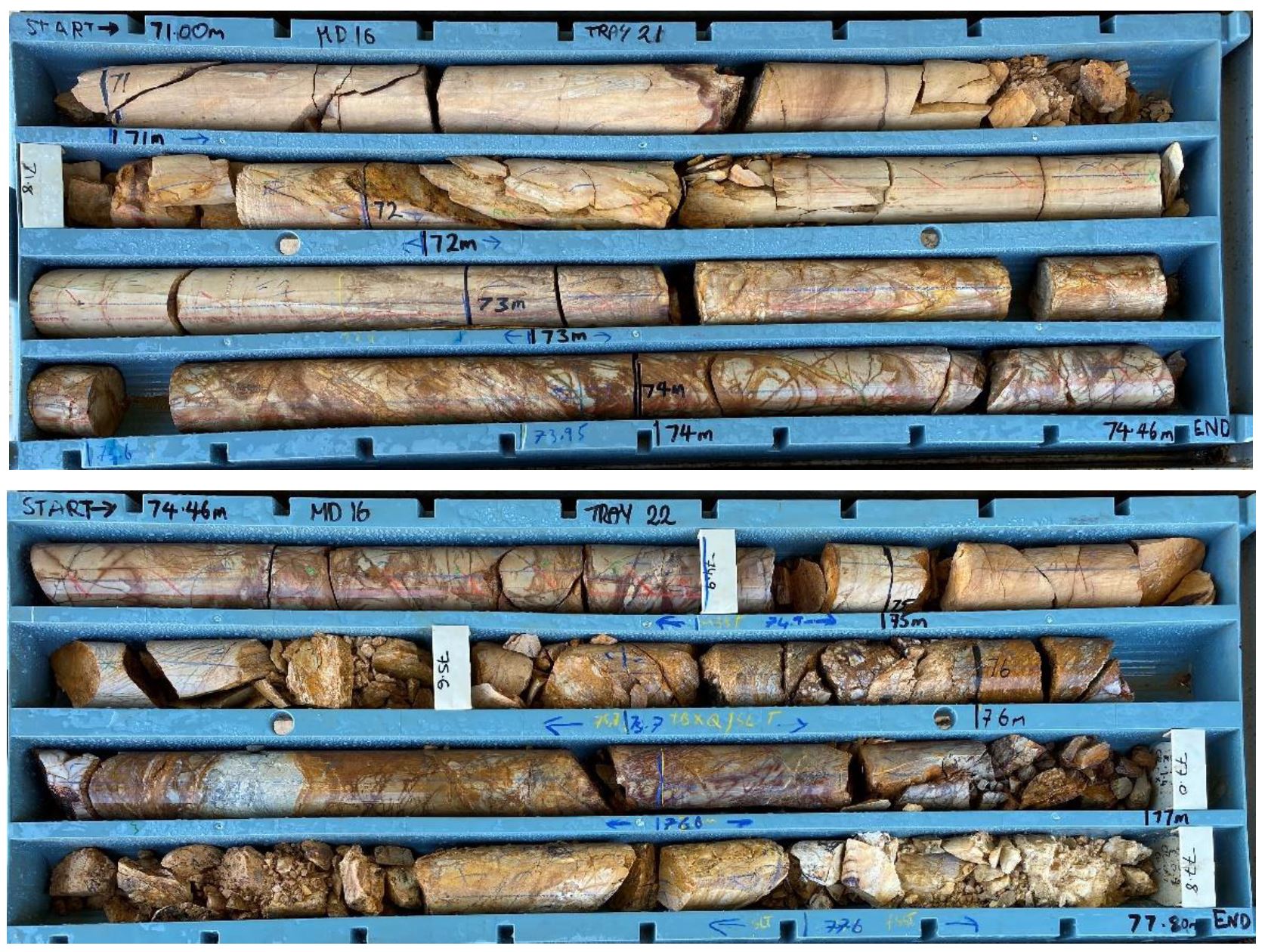


The above references an opinion and is for information purposes only. It is not intended to be investment advice. Seek a licensed professional for investment advice. The author is not an insider or shareholder of any of the companies mentioned above.

Collective Mining (TSXV:CNL) has announced major assay results from the Olympus Target within the Gauayabales project in Colombia. The results were from four additional diamond drill holes, and included 216.7m grading 1.08g/t gold equivalent. The company has also expanded the target area for follow-up exploration based on revised geological modelling data. Guayabales has seen multiple discoveries and follow-up drilling, as part of the minimum 20,000-metre program in 2022. The drill program is fully financed, with three diamond drill rigs operating at various targets.
Ari Sussman, Executive Chairman of Collective Mining, commented in a press release: “The Olympus target is advancing rapidly due to our exploration work and geological understanding and this has resulted in a 125 percent expansion of the target area. We are extremely excited about the precious metal potential of the system given the broad intercepts of gold and silver mineralization encountered in early drilling, the sheer size of the alteration system and the plethora of high-grade gold and silver-bearing, porphyry related, CBM veins. All the ingredients are in place for Olympus to evolve into a multi-million-ounce precious metal deposit. As our team understands full-well from our prior experience of exploring and developing the Buriticá project in Colombia, porphyry-related CBM veins can demonstrate robust continuity over significant vertical and lateral dimensions. Analogous to Olympus are both the multi-million-ounce high-grade Marmato and Buriticá systems, with each deposit measuring more than 1.5 vertical kilometres. The Marmato project is located approximately 3 kilometres to the southeast of Olympus and is situated within the same structurally controlled, porphyry intrusion – CBM vein, corridor.”
Highlights from the drill results are as follows:
- As a result of geological modelling, drilling, underground sampling and detailed mapping, the Company now interprets Olympus Central and Olympus South to be one large interconnected mineralized system measuring up to 1.4 kilometres north-south by 900 metres east-west. The area, which will now be referred to simply as “Olympus,” remains open for expansion to the northwest, west, south and east.
- Olympus hole OLCC-4 was drilled westward at a 60-degree angle and intersected both the mineralized Eastern and Western zones. The Eastern Zone is hosted primarily within porphyry diorite and has carbonate base metal (“CBM”) veins overprinting it while the Western Zone is hosted predominately within schist country rock impregnated by multiple zones of sheeted CBM veins with results as follows:
- 216.7 metres @ 1.08 g/t gold equivalent from 73 metres down-hole (Eastern Zone, drill hole OLCC-4)
- 110.1 metres @ 0.82 g/t gold equivalent from 480.3 metres down-hole (Western Zone, drill hole OLCC-4)
- Olympus hole OLCC-5 was drilled to the northwest at 70-degree angle and intercepted the Eastern Zone as follows:
- 59.6 metres @ 1.02 g/t gold equivalent from 11 metres down-hole before crossing into a late phase intrusion which appears to have eliminated the mineralization in this location. Additional patchy mineralization in the Eastern Zone was encountered further down-hole including 25.3 metres @ 0.86 g/t gold equivalent. The Company will focus future drilling in the Eastern Zone along strike to the south where it remains wide open for expansion. Lastly, this hole was not drilled far enough to intersect the projection of the Western Zone.
- Recent surface mapping and interpretation of drill data has led to a refinement of the Company’s model for the Western Zone. The schist-intrusive contact is shallow dipping and daylights at surface in the west for at least 200 metres of strike. Future drilling will target the untested, shallow projection of the Western Zone. Holes OLCC-6 and OLCC-7 were unfortunately, not drilled deep enough to intersect this Western Zone projection at depth (see Figure 3).
- Exploration work to date within both historical and current artisanal mines has outlined more than 25 veins. Previously announced chip channel sampling assay results have confirmed the high-grade nature of the veins with precious and base metal grades assaying up to 485 g/t gold, 1,919 g/t silver, 2.86% copper and combined zinc and lead grades in excess of 25 percent. Drilling completed thus far by the Company has been principally focused on the northern portion of the eastern zone and has not therefore tested below these high grade, artisanal mines. An extensive chip channel sampling campaign has been undertaken within the old mines with assay results anticipated in the near term.
Table 1: Assay Results

*AuEq (g/t) is calculated as follows: (Au (g/t) x 0.95) + (Ag g/t x 0.017 x 0.95) + (Cu (%) x 2.06 x 0.95) + (Mo (%) x 6.86 x 0.95), utilizing metal prices of Cu – US$4.50/lb, Mo – US$15.00/lb, Ag – $25/oz and Au – US$1,500/oz and recovery rates of 95% for Au, Ag, Cu and Mo.
Recovery rate assumptions are speculative as no metallurgical work has been completed to date.
** A 0.1 g/t AuEq cut-off grade was employed with no more than 10% internal dilution. True widths are unknown, and grades are uncut.
*** No significant values reported in this intercept
Figure 2: Plan View of the Olympus Target

Figure 3: Cross Section W-E as Outlined on the Olympus Plan View Image

Figure 4: Drill Hole OLCC-4 Core Photos

The above references an opinion and is for information purposes only. It is not intended to be investment advice. Seek a licensed professional for investment advice. The author is not an insider or shareholder of any of the companies mentioned above.
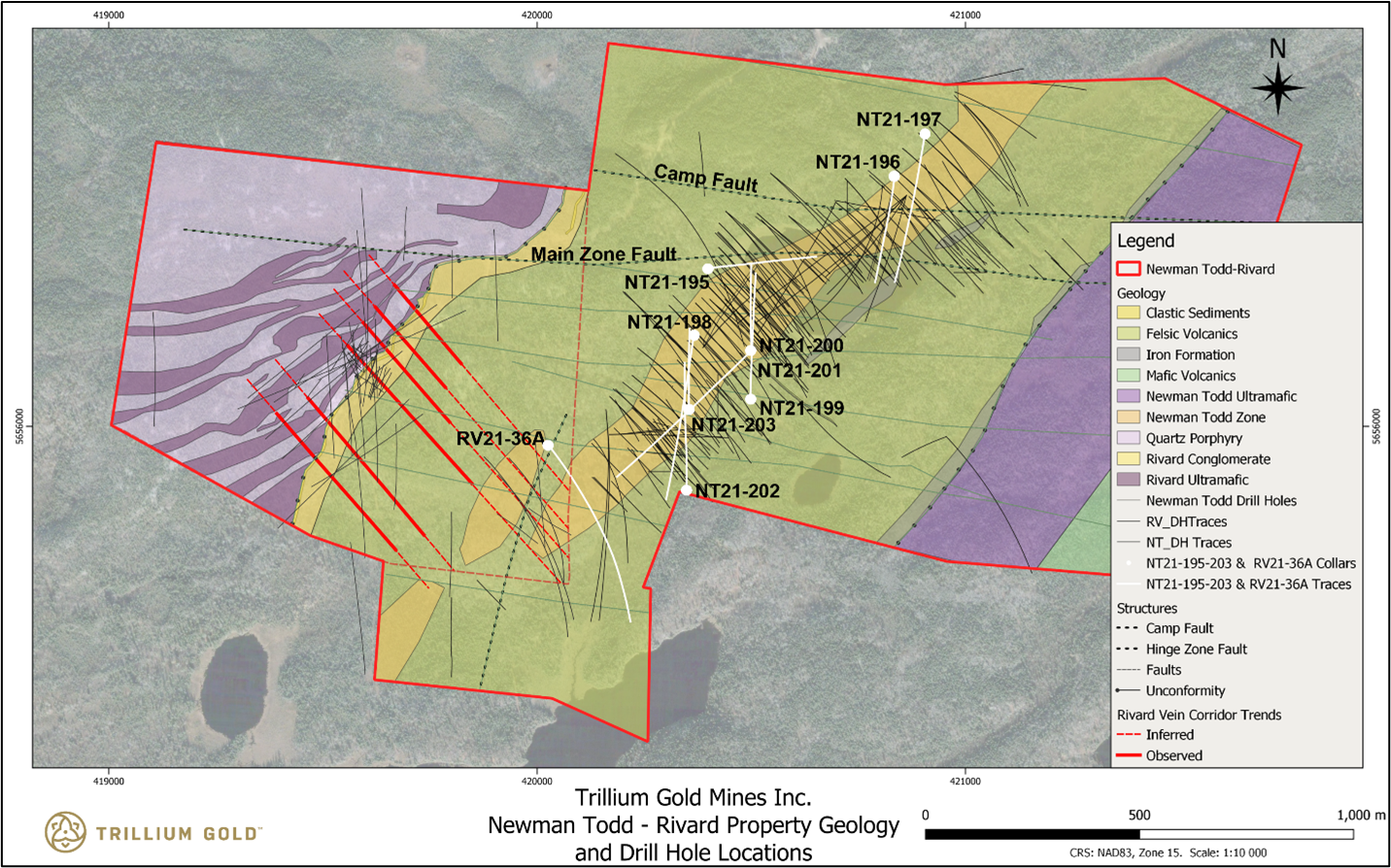
Trillium Gold Mines (TSXV:TGM) (OTC:TGLDF) has reported new results from the Newman Todd Complex from drill holes NT21-195 to -203 and RV21-36A. The holes were last drilled in the final quarter of 2021, but due to a general backlog in assay laboratory turnaround, final results were only received in late March 2022.
This group of drill holes were intended to follow up on previous results and begin testing of newly interpreted east-west structural corridors cutting through the NT Zone.
William Paterson, Trillium Gold’s Vice President of Exploration commented in a press release: “We continue to intersect significant mineralization as we follow up on the known east-west structures within the NT Zone and have received additional significant results as we begin to test new interpreted structures further southeast along the NT Zone. Our structural model and interpreted controls on the gold mineralization seem to be holding up well. Further work is necessary, but we are confident that subsequent drilling will yield similar results as we continue our work. We also feel it is time to commence testing high-priority structural targets both east and west of the NT Zone in order to begin expanding the resource footprint in the greater project area.”
Highlights from the results are as follows:
- 4 metres @ 24.2 g/t gold including 1.15 metres @ 73.67 g/t gold from NT21-202 in a new east-west fault corridor more than 400 metres southwest along the NT Zone from the Main Zone Fault
- Wide zone of 15.5 metres @ 4.6 g/t gold containing 1.45 metres @ 35.86 g/t Au from 247 metres downhole in NT21-196
- Testing and confirming gold mineralization on multiple east-west structures cutting through the NT Zone
Hole NT21-195 targeted high-grade Rivard-style quartz vein mineralization along the footwall contact of the NT Zone where two of the more significant results were found in siliceous NT Zone breccia segments offset into the footwall along E-W faults.
Holes NT21-196 and -197 followed up on previous significant intersections associated with hole NT21-194 (9m @ 19.73 g/t Au) and the Camp Zone Fault (see NR dated September 23, 2021). Hole NT21-196 was drilled above hole NT21-194 and intersected mineralized portions of the NT Zone with veining containing visible gold (VG) associated with galena and sphalerite, located in the footwall contact area. Hole NT21-197 stepped back to collar in the Camp Fault area testing the down-dip continuity of mineralization and the E-W Main Zone Fault structure. Both holes returned numerous significant assay results; NT21-196 throughout the hole, with VG seen in quartz veins between 257.8m and 259.4m, and in the lower portion of NT21-197, in the Main Zone Fault area. See Figures 1 and 2.
Figure 2: Long Section view (looking northwest) showing NT Zone model, exploration block model, historical results and significant intersections from NT21-195 to NT21-203 and RV21-36A.

In the south region of the Main Zone portion of the NT Zone, a series of holes (NT21-198 to -203) were drilled to the north and south across known and newly interpreted E-W breccia fault corridors crossing the NT Zone, often seen associated with better grade mineralization and Rivard-style quartz vein clusters along the fault trends. The Rivard-style vein intersected in NT21-202 at 262.25 – 264.2m contained multiple specks of VG and assayed 4m @ 24.2 g/t Au. All the holes returned grades and widths as expected, supporting the interpretation that these E-W structural corridors are influencing and focusing gold in the NT Zone.
In the southwest portion of the NT Zone, hole RV21-36A was drilled to assist in refining the model for the south portion of the NT Zone, as well as the SW Zone, and greatly extends the depth and extents of known mineralization. The hole first intersected the SW Zone showing patchy mineralization followed by a second breccia zone, towards the southeast, correlating to the NT Zone proper. In addition, the VG located in a sheared felsic volcanic section (at 695.5m) and in a quartz lens (at 705.5m), in the lower portion of the hole, expands the limits of VG occurrences cored in the project area. The E-W fault corridor associated with this gold mineralized zone is a new addition into our model for future targeting. Two very significant intercepts were received from this hole of 0.45m @ 17.5 g/t Au from 695.35m and 12m @ 3.08 g/t Au from 704m (including 1m @ 22.6 g/t Au). This hole was only stopped due to diminishing drill productivity.
Table 1: Highlights of significant intercepts from holes NT21-195 to -203 & RV21-36A. A full listing of Significant Intercepts can be found on Trillium Gold’s website (www.trilliumgold.com).
| Hole ID | From (m ) | To (m) | Width (m) | Au (g/t) | |
| NT21-195 | 200 | 200.5 | 0.5 | 15.2 | |
| NT21-196 | 25.25 | 25.6 | 0.35 | 13.1 | |
| 147 | 192 | 45 | 1.07 | ||
| Incl. | 155.5 | 162 | 6.5 | 3.02 | |
| and | 160 | 162 | 2 | 5.35 | |
| 224 | 236 | 12 | 2.23 | ||
| Incl. | 226 | 232 | 6 | 4.18 | |
| and | 231 | 232 | 1 | 21.8 | |
| 241 | 316 | 75 | 1.86 | ||
| Incl. | 242 | 243 | 1 | 12.2 | |
| Incl. | 247 | 262.5 | 15.5 | 4.6 | |
| and | 258 | 259.45 | 1.45 | 35.86 | |
| Incl. | 266 | 268 | 2 | 4.58 | |
| Incl. | 283.3 | 291 | 7.7 | 2.43 | |
| and | 283.3 | 284 | 0.7 | 6.38 | |
| NT21-197 | 420 | 448 | 28 | 1.85 | |
| Incl. | 421.8 | 424.8 | 3 | 2.95 | |
| Incl. | 437.55 | 442 | 4.45 | 5.08 | |
| and | 439.4 | 440.15 | 0.75 | 24.3 | |
| NT21-198 | 506 | 508 | 2 | 5.14 | |
| NT21-199 | 223 | 257 | 34 | 1.14 | |
| Incl. | 224.8 | 230 | 5.2 | 2.53 | |
| and | 224.8 | 225.65 | 0.85 | 6.67 | |
| and | 229.4 | 230 | 0.6 | 9.85 | |
| and | 247 | 247.6 | 0.6 | 6.33 | |
| NT21-201 | 215 | 216 | 1 | 24.8 | |
| NT21-202 | 151 | 156 | 5 | 2.58 | |
| Incl. | 152 | 153 | 1 | 11.1 | |
| 262 | 266 | 4 | 24.2 | ||
| Incl. | 262.85 | 264 | 1.15 | 73.67 | |
| NT21-203 | 83.25 | 85 | 1.75 | 8.51 | |
| Incl. | 83.85 | 84.53 | 0.68 | 21.4 | |
| RV21-36A | 695.35 | 695.8 | 0.45 | 17.5 | |
| 704 | 716 | 12 | 3.08 | ||
| Incl. | 705 | 706 | 1 | 22.6 | |
| Incl. | 713 | 714 | 1 | 8.67 | |
Table 2: Drill collar details for drill holes NT21-195 to -203 and RV21-36A – UTM zone 15, NAD 83.
| Hole ID | Easting | Northing | Elevation | Length (m) | Dip | Azimuth |
| NT21-195 | 420400 | 5656370 | 359 | 342 | -45 | 86 |
| NT21-196 | 420835 | 5656584 | 365 | 336 | -45 | 190 |
| NT21-197 | 420905 | 5656679 | 359 | 462 | -45 | 190 |
| NT21-198 | 420366 | 5656216 | 366 | 570 | -49 | 188 |
| NT21-199 | 420498 | 5656071 | 367 | 422 | -51 | 1 |
| NT21-200 | 420500 | 5656177 | 367 | 272 | -45 | 1 |
| NT21-201 | 420500 | 5656177 | 365 | 572 | -47 | 224 |
| NT21-202 | 420349 | 5655855 | 358 | 383 | -45 | 1 |
| NT21-203 | 420354 | 5656037 | 360 | 263 | -47 | 1 |
| RV21-36A* | 420025 | 5655958 | 384 | 947 | -62 | 135 |
* Note: Drillhole RV21-36 was abandoned at 21m.
The above references an opinion and is for information purposes only. It is not intended to be investment advice. Seek a licensed professional for investment advice. The author is not an insider or shareholder of any of the companies mentioned above.
South Atlantic Gold (TSXV:SAO) has announced it has completed a trenching program as part of the Phase II exploration program at Pedra Branca, a project in northeastern Brazil. The highest grading intersection at surface identified was with 3 metres grading 38 grams per tonne gold, after the trenching program assayed more than 200 mineralized intersections.
Douglas Meirelles, the CEO of South Atlantic Gold, commented in a press release: “The Company has successfully completed all trenches for the Phase II exploration program at Pedra Branca. The results have arrived and are being reported as we work to consolidate the data. We have now completed a major milestone and have filed all the final required exploration reports with ANM and expect that these 15 tenements will be approved for the next phases in the process and will be converted from exploration into mining concessions. As shown with the Phase I exploration program, we continue to achieve our objectives on time and on budget.”
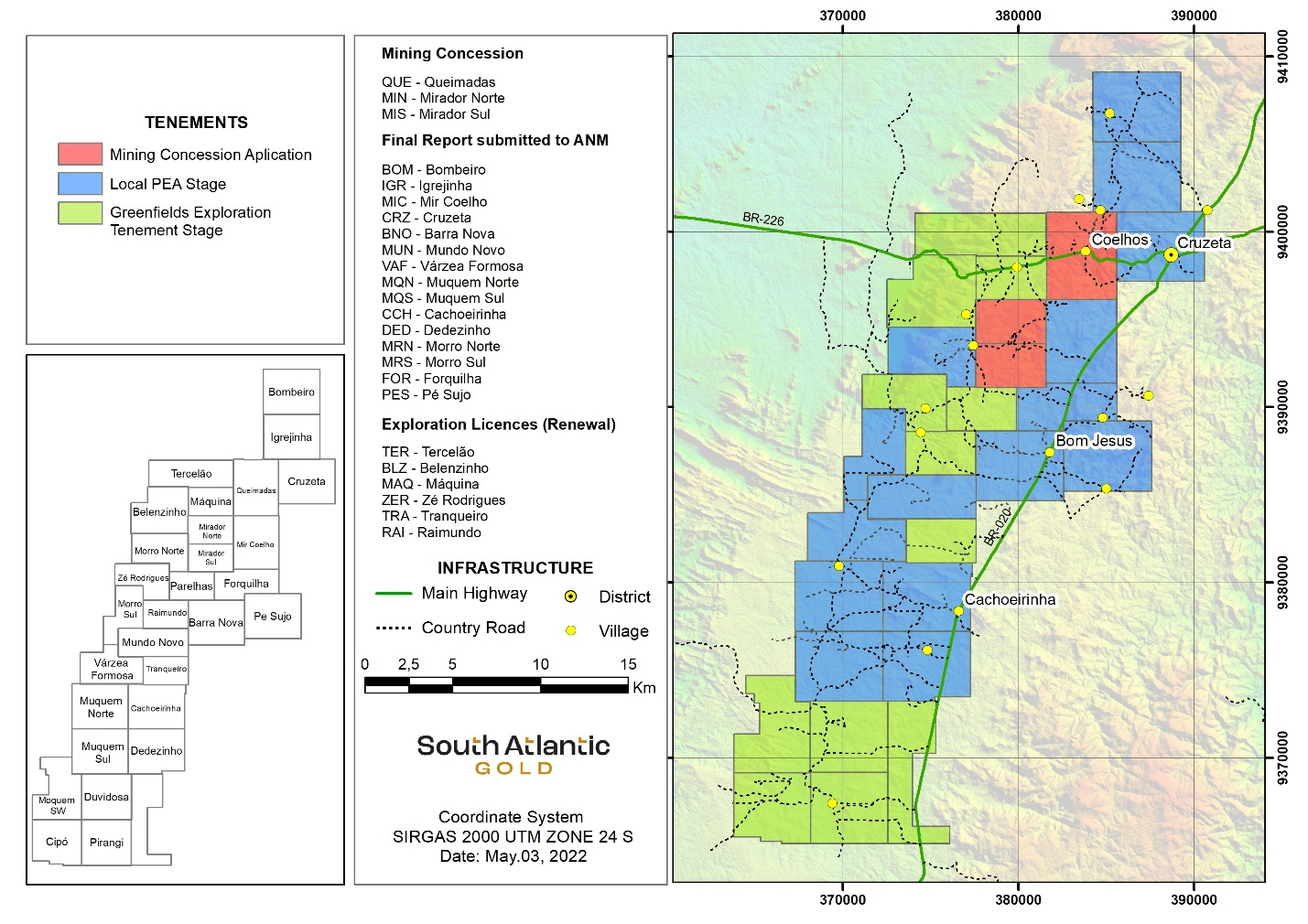
The highlights of the Phase II trenching program are as follows:
| Trenches (TR) and Reverse Circulation (RC) Drilling Ore Intercepts | |||||||
| >= 0.4 g/t Au | Id | Type | Intercepts | From | To | Target | ANM Process |
| PBTR047 | TR | 3 m @ 32.63 g/t Au incl. 1 m @ 96.04 g/t Au | 21 | 23 | Barra Nova | 801.059/2011 | |
| PBTR048 | TR | 1 m @ 1.58 g/t Au | 139 | 140 | Barra Nova | 801.059/2011 | |
| PBTR106 | TR | 8 m @ 0.94 g/t Au incl. 2 m @ 3.3 g/t Au | 12 | 20 | Cachoeirinha | 801.054/2011 | |
| PBTR108 | TR | 6 m @ 0.78 g/t Au incl. 2 m @ 1.75 g/t Au | 176 | 182 | Cachoeirinha | 801.054/2011 | |
| PBTR098 | TR | 2 m @ 0.59 g/t Au | 18 | 20 | Moquem Norte | 800.605/2012 | |
| PBTR098 | TR | 2 m @ 0.54 g/t Au | 350 | 352 | Moquem Norte | 800.605/2012 | |
| PBTR096 | TR | 2 m @ 0.47 g/t Au | 118 | 120 | Moquem Norte | 800.605/2012 | |
| PBTR097 | TR | 2 m @ 0.45 g/t Au | 114 | 116 | Moquem Norte | 800.605/2012 | |
| PBTR099 | TR | 2 m @ 0.41 g/t Au | 246 | 248 | Moquem Norte | 800.605/2012 | |
| PBTR105 | TR | 2 m @ 0.475 g/t Au | 104 | 106 | Cachoeirinha | 801.054/2011 | |
| >= 0.1 g/t Au | Id | Intercepts | From | To | Target | ANM Process | |
| PBTR108 | TR | 8 m @ 0.16 g/t Au incl. 2 m @ 0.38 g/t Au | 94 | 102 | Cachoeirinha | 801.054/2011 | |
| PBTR108 | TR | 8 m @ 0.18 g/t Au incl. 2 m @ 0.29 g/t Au | 62 | 70 | Cachoeirinha | 801.054/2011 | |
| PBTR121 | TR | 16 m @ 0.11 g/t Au incl. 4 m @ 0.302 g/t Au | 150 | 166 | Mundo Novo | 801.049/2011 | |
| PBTR095 | TR | 8 m @ 0.17 g/t Au incl. 2 m @ 0.28 g/t Au | 102 | 110 | Moquem Norte | 800.605/2012 | |
| PBTR094 | TR | 4 m @ 0.22 g/t Au | 202 | 206 | Moquem Norte | 800.605/2012 | |
| PBTR105 | TR | 4 m @ 0.23 g/t Au | 92 | 96 | Cachoeirinha | 801.054/2011 | |
| PBTR126 | TR | 2 m @ 0.17 g/t Au | 44 | 46 | Dedezinho | 800.602/2012 | |
| PBTR115 | TR | 8 m @ 0.17 g/t Au | 78 | 86 | Barra Nova | 801.054/2011 | |
| PBTR120 | TR | 2 m @ 0.15 g/t Au | 240 | 242 | Mundo Novo | 801.049/2011 | |
| PBTR108 | TR | 2 m @ 0.12 g/t Au | 198 | 200 | Cachoeirinha | 801.054/2011 | |
| PBTR095 | TR | 8 m @ 0.116 g/t Au | 134 | 138 | Moquem Norte | 800.605/2012 | |
| PBTR105 | TR | 2 m @ 0.11 g/t Au | 78 | 80 | Cachoeirinha | 801.054/2011 | |
| PBTR106 | TR | 8 m @ 0.105 g/t Au | 32 | 36 | Cachoeirinha | 801.054/2011 | |
| PBTR108 | TR | 8 m @ 0.11 g/t Au | 148 | 156 | Cachoeirinha | 801.054/2011 | |
| PBTR095 | TR | 2 m @ 0.1 g/t Au | 150 | 152 | Moquem Norte | 800.605/2012 | |
The current status of the tenements of Pedra Branca can be seen on the graphic below. We have successfully submitted the final exploration report of 15 tenements and are advancing it to a PEA stage within ANM (“Agencia Nacional de Mineração”) as required by local legislation. We have also identified high grade results and several continuously mineralized samples over the entire south portion of the Pedra Branca asset as seen on the table of trench assay results.
Source: South Atlantic Gold Inc.
The above references an opinion and is for information purposes only. It is not intended to be investment advice. Seek a licensed professional for investment advice. The author is not an insider or shareholder of any of the companies mentioned above.
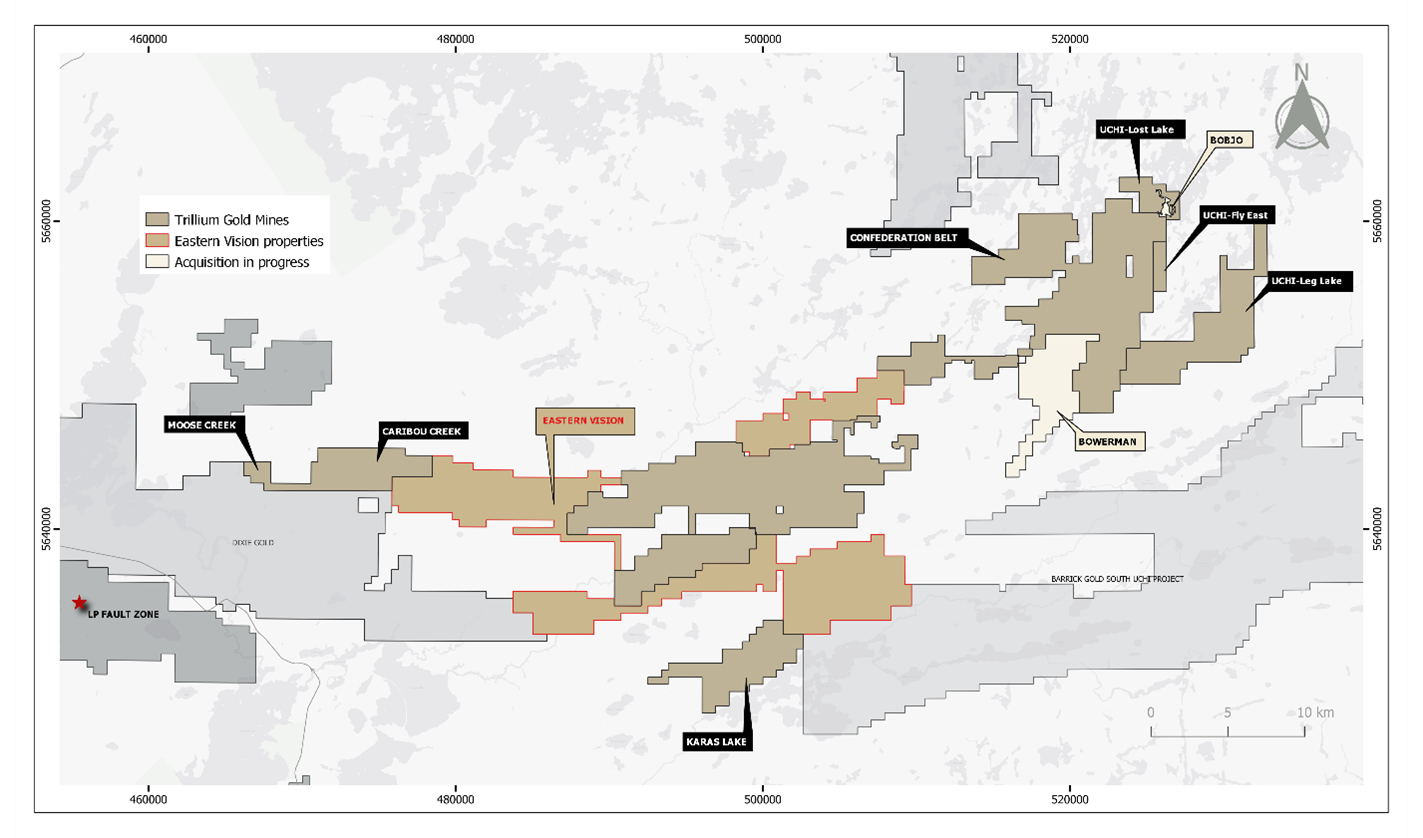
Trillium Gold (TSXV:TGM) has announced that it has signed a Definitive Agreement to acquire most of Imagine Lithium’s Eastern Vision properties in the Confederation lake assemblage. This sits within the Birch-Uchi greenstone belt in the Red Lake Mining District of Ontario. The property package now comprises 13,958 hectares between the Fedart, Confederation North, and Confederation South properties.
Trillium Gold has been acquiring and assembling a dominant land package at Confederation Lake, and has created a strategic contiguous land package. This land package is more than 100km of favourable structure on trend with Kinross Gold’s important Dixie Deposit and Evolution Mining’s Red Lake Operation.
Details of the agreement are as follows:
Concurrent with the closing of the Definitive Agreement, Trillium Gold will pay to Pegasus Resources Inc. (“Pegasus”) $20,000 in cash, as well as 100,000 common shares in the capital of Trillium Gold to earn into certain option agreements that Trillium is assuming as options from Imagine Lithium under the Definitive Agreement. The cash consideration represents the remaining option payments under said option agreements, while the equity consideration purchases Pegasus’ carried interest in the relevant properties such that Trillium Gold will be transferred 100% of those properties upon closing of the Definitive Agreement.
Trillium Gold has also entered into a Royalty Purchase Agreement under which it will, concurrently with the closing of the Definitive Agreement, purchase a 2.0% NSR royalty on the Fredart property from prospector Perry English in consideration for the issuance of 60,000 common shares in the capital of Trillium Gold and $50,000 in cash.
The Definitive Agreement and the transactions contemplated thereunder, including purchasing Pegasus’ carried interest in properties covered by certain option agreements and entering into the Royalty Purchase Agreement, remain subject to TSXV approval.
Source:Trillium Gold Mines
The above references an opinion and is for information purposes only. It is not intended to be investment advice. Seek a licensed professional for investment advice. The author is not an insider or shareholder of any of the companies mentioned above.
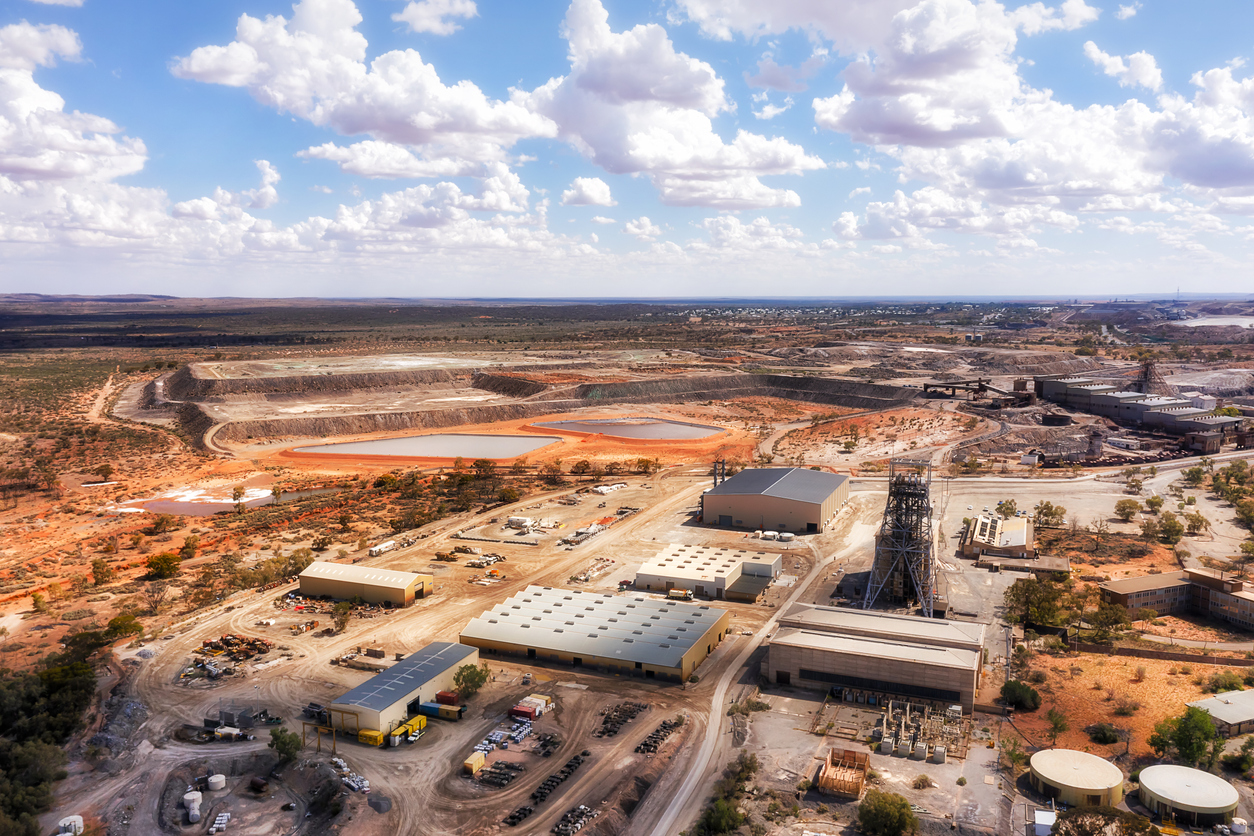
Nyrstar Australia is now planning to invest $285 million in a new electrolysis plant in Tasmania, Australia. The Hobart Zinc Works facility, as it will be known, is going to use the latest zinc technologies to bring about rapid change to increase the competitiveness of Zinc Works and Australian zinc in general. Zinc Works will also be able to facilitate more recovery of minerals and metals from the Nyrstar Port Pirie facility.
The new work on the facility should be completed in 28 months and has already received approval from the Glenorchy City Council and the Environment Protection Authority of Tasmania.
Zinc electrolysis is a process of converting zinc oxide into pure metallic zinc. It is currently the most efficient method of producing high-purity metallic zinc commercially and has become popular in Australia as it will help reduce dependency on imported metals. The Nyrstar Hobart smelter is known as one of the largest zinc smelters in the world and is integrated closely with Port Pirie’s smelter. Port Pirie process es the paragoethite by-product and other leach by-products from Hobart.
The new facility promises to be a real boon not just for Zinc Works but also for the entire Australian mining industry, as it will help to make the country more self-sufficient in terms of zinc production. It is also hoped that the new plant will create jobs and provide a boost to the local economy.
The construction phase alone is expected to create u to 200 job opportunities. 500 direct jobs in Tasmania will be created from the new plant. At Nyrstar’s Hobart and Port Pirie operations, approximately 1,600 direct and 5,000 indirect jobs will be created due to the new project.
Zinc and The New Economy
As lithium, copper, and cobalt usually take centre stage when it comes to the electric energy transition, less is sometimes mentioned of zinc. As an important by-product of the global lead market, zinc is often overshadowed by its more glamorous peers. But this shouldn’t be the case as zinc has unique characteristics which make it critical to the new economy.
Zinc is an essential metal for human health and is used in a variety of industries, from construction to automotive manufacturing. It’s also used in batteries, particularly for electric vehicles. In fact, zinc is a key component of the cathode in lithium-ion batteries and is used in smaller quantities in other types of batteries as well.
Zinc is also used in solar energy applications. It’s an important material for thin-film solar cells as it can be deposited onto a substrate in a very thin layer.
The mining industry has been preparing for a boost in demand for zinc, and Australia is looking to position itself as one of the world’s leading suppliers. Zinc electrolysis is one of the ways in which Australia is meeting this demand, and companies like Nyrstar are playing an important role in helping to drive this industry forward with the newest technologies.
The above references an opinion and is for information purposes only. It is not intended to be investment advice. Seek a licensed professional for investment advice. The author is not an insider or shareholder of any of the companies mentioned above.
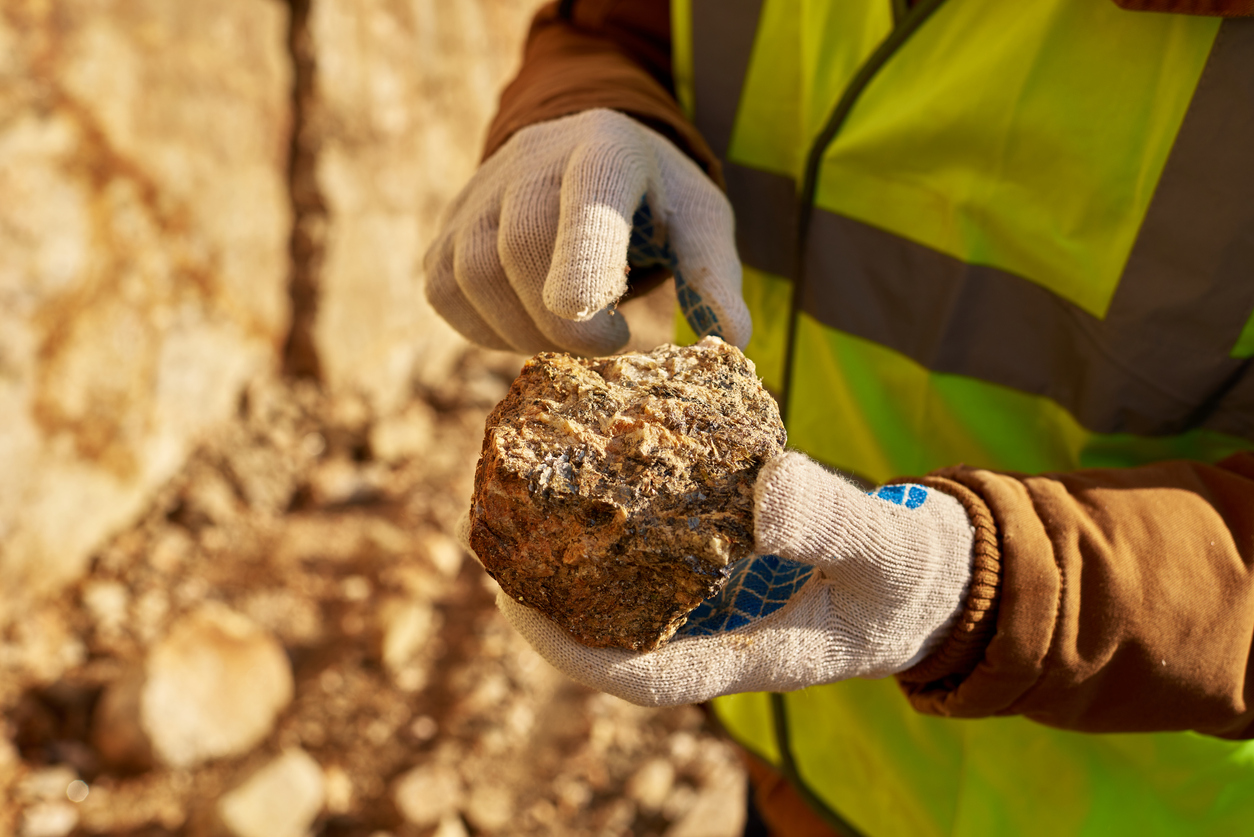
Sandstorm Gold (TSX:SAND) announced yesterday that it had agreed to an all-share transaction worth $590 million to buy Nomad Royalty. On top of that deal, Sandstorm also agreed to acquire nine other royalties and a stream for $525 million in cash and stock from BaseCore Metals. This is part of Sandstorm’s strategic growth plan to solidify its position further to become the highest-growth, highest-liquidity mid-tier royalty and streaming company.
Nolan Watson, Sandstorm Gold’s president and chief executive, commented: “We believe that precious metals and copper are poised to materially outperform the market in the coming years, and we are excited to provide investors with exposure to long-life, high quality, and low-cost assets focused on gold, silver and copper.”
The deals represent further revenue for Sandstorm as $27 million in revenue was contributed from Nomad’s portfolio last year, representing approximately 16,000 gold equivalent ounces. The other deal involves the joint venture between Glencore and the Ontario Teachers’ Pension Plan Board known as BaseCore Metals. The company’s portfolio holds ten royalty and streaming assets. Three of the ten are for producing assets.
The royalty format involves a company paying the owner of a mineral deposit a percentage of revenue or profit in exchange for the right to mine that deposit. The streaming deal gives Sandstorm the right to purchase all or part of the future production from a mine at a set price.
Royalty and streaming deals have become more popular in the past decade as they have many benefits: they offer exposure to a commodity and diversification from the risky mining business, they can be bought through an exchange-traded fund (ETF), and they are also relatively low cost.
The expected production boost in 2022 from the transactions for Sandstorm Gold could be up to 22% to hit between 80,000 and 85,000 gold equivalent ounces. This would be an increase from previous guidance which showed estimates of 65,000 to 70,000 gold equivalent ounces. However, the main highlight is the production boost the company expects in the next three years. By 2025, the company has said that the two key acquisitions will increase production by up to 55%, to reach 155,000 ounces.
The above references an opinion and is for information purposes only. It is not intended to be investment advice. Seek a licensed professional for investment advice. The author is not an insider or shareholder of any of the companies mentioned above.
Trillium Gold Mines (TSXV:TGM) has announced that it has closed the previously reported purchase option agreements for the Satterly Gold Project and the Uchi Gold Projects. This is a major step for the company in building its dominant land position in the Confederation belt and Birch-Uchi greenstone belts within the Red Lake Mining District.
Uchi Gold Agreement
The Uchi Gold Agreement comprises one hundred and eighty-two (182) unpatented mining claims covering 4,189 hectares immediately adjacent to and adjoining the Company’s Confederation belt land position. They consist of the contiguous and complementary Lost Bay, Fly East and Leg Lake mining claims that extend the Company’s existing Confederation belt property assemblage to the northeast towards the Satterly Lake property, and add to Trillium’s dominant position over 100km of favourable structure on trend with Kinross Gold’s Dixie deposit (see Figures 1 & 2 below).
In order to keep the option in good standing, Trillium Gold is required to pay aggregate consideration of $115,000 over a period of three years, issue an aggregate 300,000 common shares, and grant to the vendors a 2.0% net smelter returns royalty on each purchased asset. The Company has the right to repurchase 50% of each royalty (being 1.0%) by paying the holders an aggregate amount equal to $1,000,000.
Satterly Gold Agreement
The Satterly Gold Agreement comprises twenty-eight (28) claim cells in five (5) claims covering 565 hectares (called Satterly North). The area has seen sporadic exploration from the 1930’s with renewed gold exploration in the 1990’s and again from 2009. (see Figure 2 below).
In order to keep the option in good standing, Trillium Gold is required to pay aggregate consideration of $63,500 over a period of three years, issue an aggregate 100,000 common shares, and grant to the vendors a 1.5% net smelter returns royalty on each purchased asset. The Company has the right to repurchase 1/3 of each royalty (being 0.5%) by paying the holders an aggregate amount equal to $500,000.
In addition, the vendors have successfully acquired sixteen (16) recently staked cells in one (1) claim covering 323 hectares at a cost equal to the costs of staking (see Figure 3 below).
Source: Trillium Gold Mines
Figure 1: Uchi Gold Option Properties

Figure 2: Uchi and Satterly Gold Option Properties

Figure 3: Satterly Gold Option Property showing sixteen (16) recently staked cells in one (1) claim

The above references an opinion and is for information purposes only. It is not intended to be investment advice. Seek a licensed professional for investment advice. The author is not an insider or shareholder of any of the companies mentioned above.
If you would like to receive our free newsletter via email, simply enter your email address below & click subscribe.
CONNECT WITH US
Tweets
Tweet with hash tag #miningfeeds or @miningfeeds and your tweets will be displayed across this site.
MOST ACTIVE MINING STOCKS
Daily Gainers
 Lincoln Minerals Limited Lincoln Minerals Limited |
LML.AX | +125.00% |
      |
GCR.AX | +33.33% |
      |
CASA.V | +30.00% |
      |
AHN.AX | +22.22% |
      |
ADD.AX | +22.22% |
      |
AZM.V | +21.98% |
      |
NSE.V | +21.05% |
      |
DYG.V | +18.42% |
      |
AAZ.V | +18.18% |
      |
GLA.AX | +17.65% |


 Follow us on Twitter
Follow us on Twitter Become our facebook fan
Become our facebook fan








